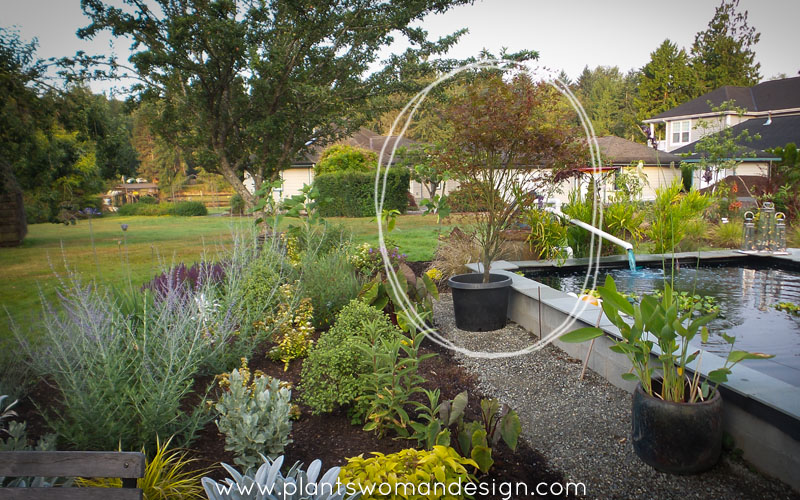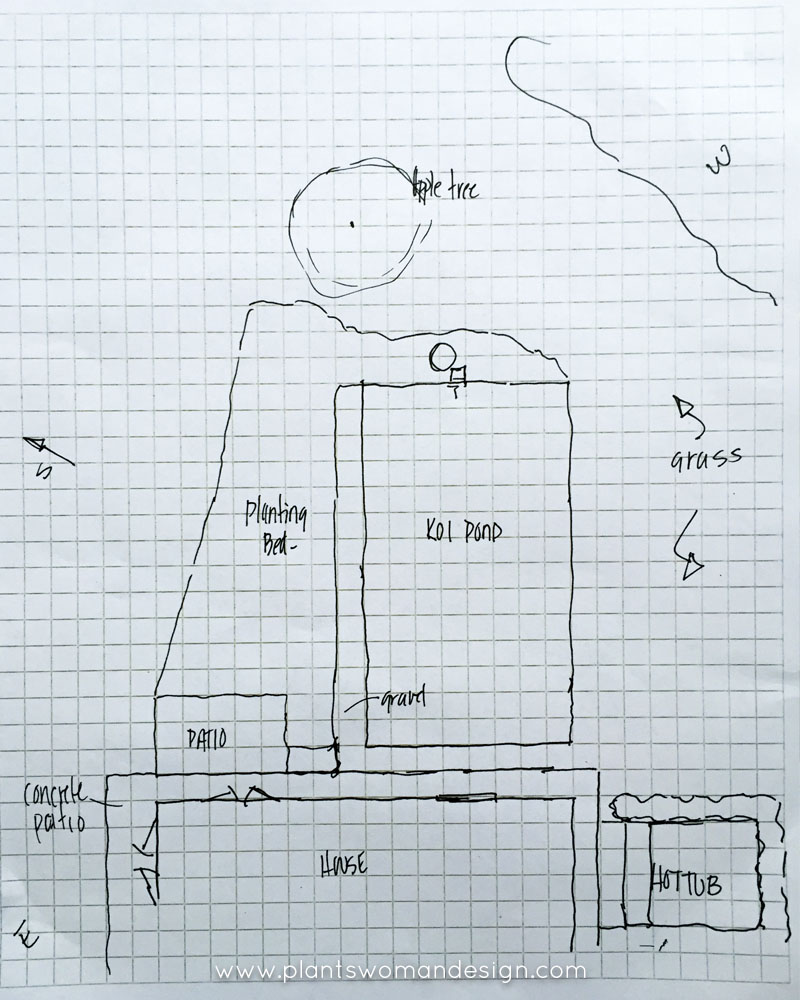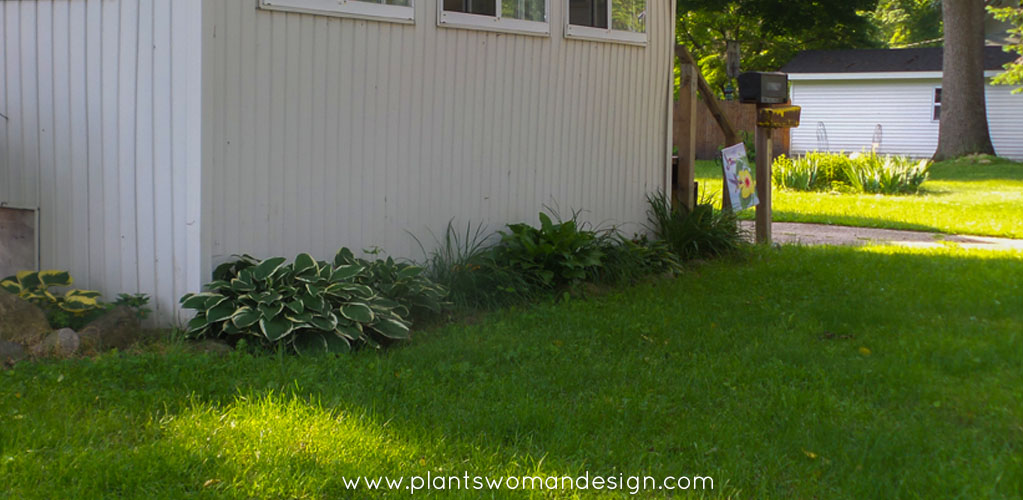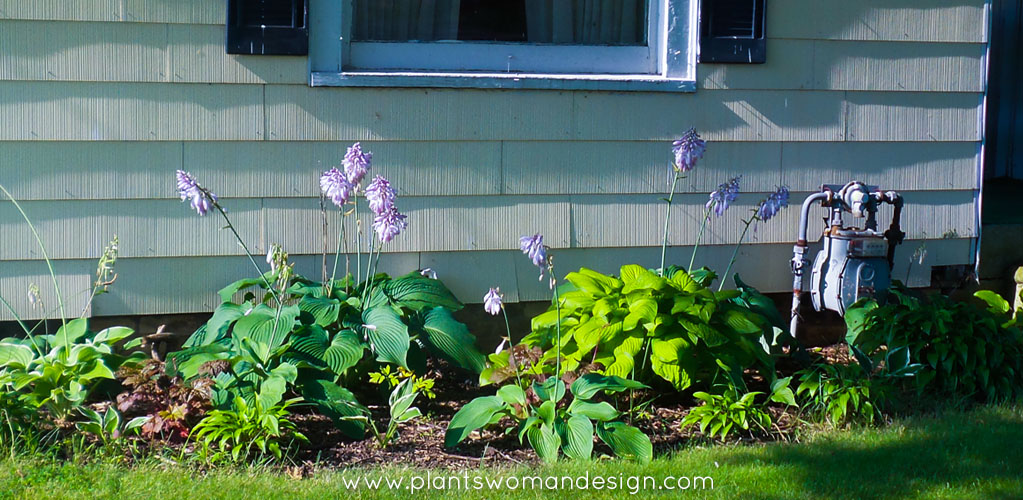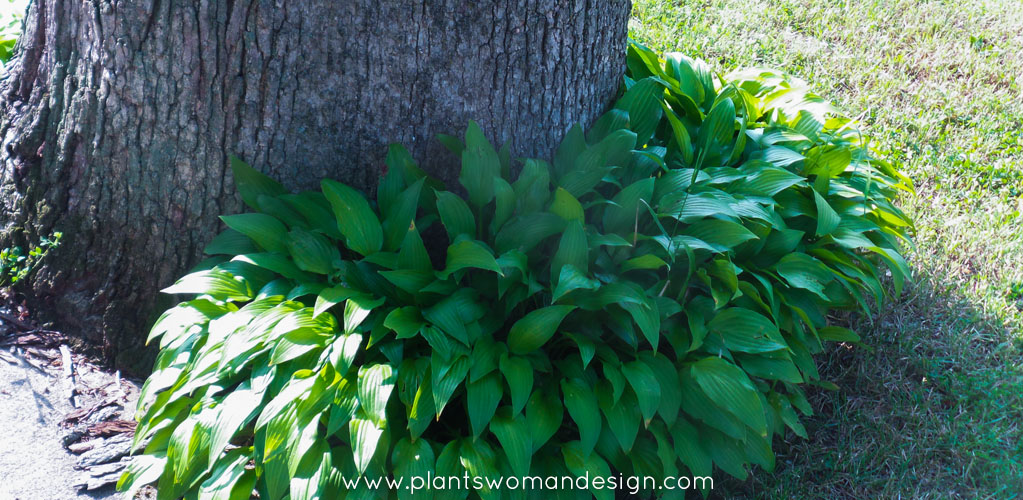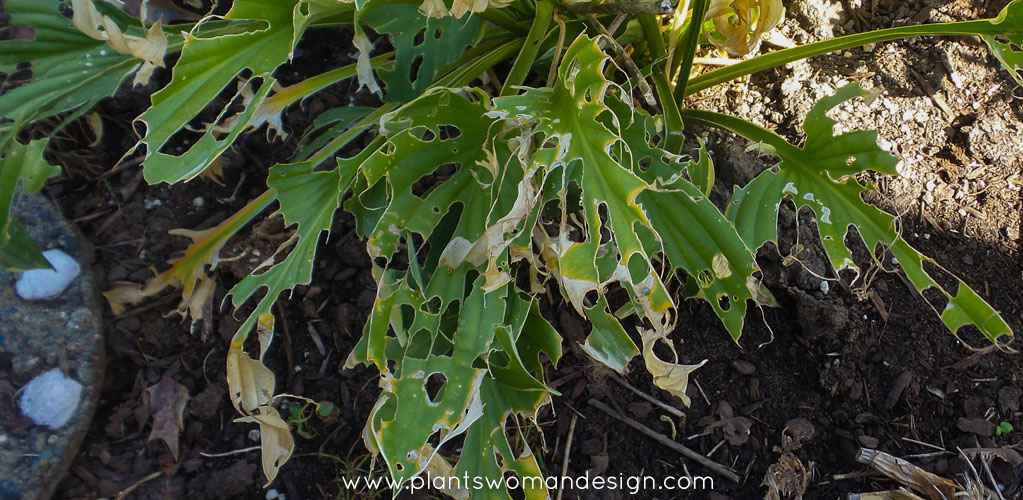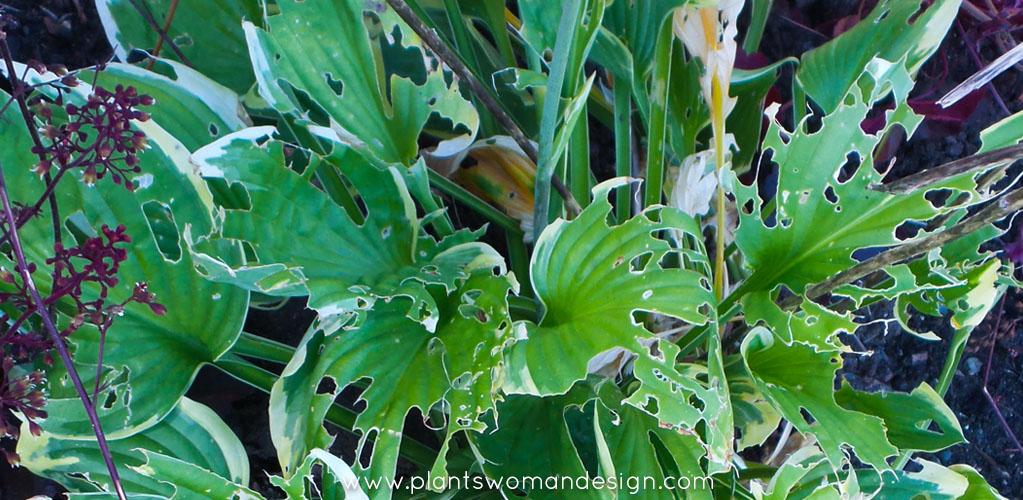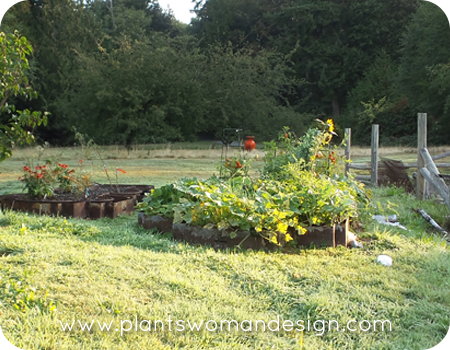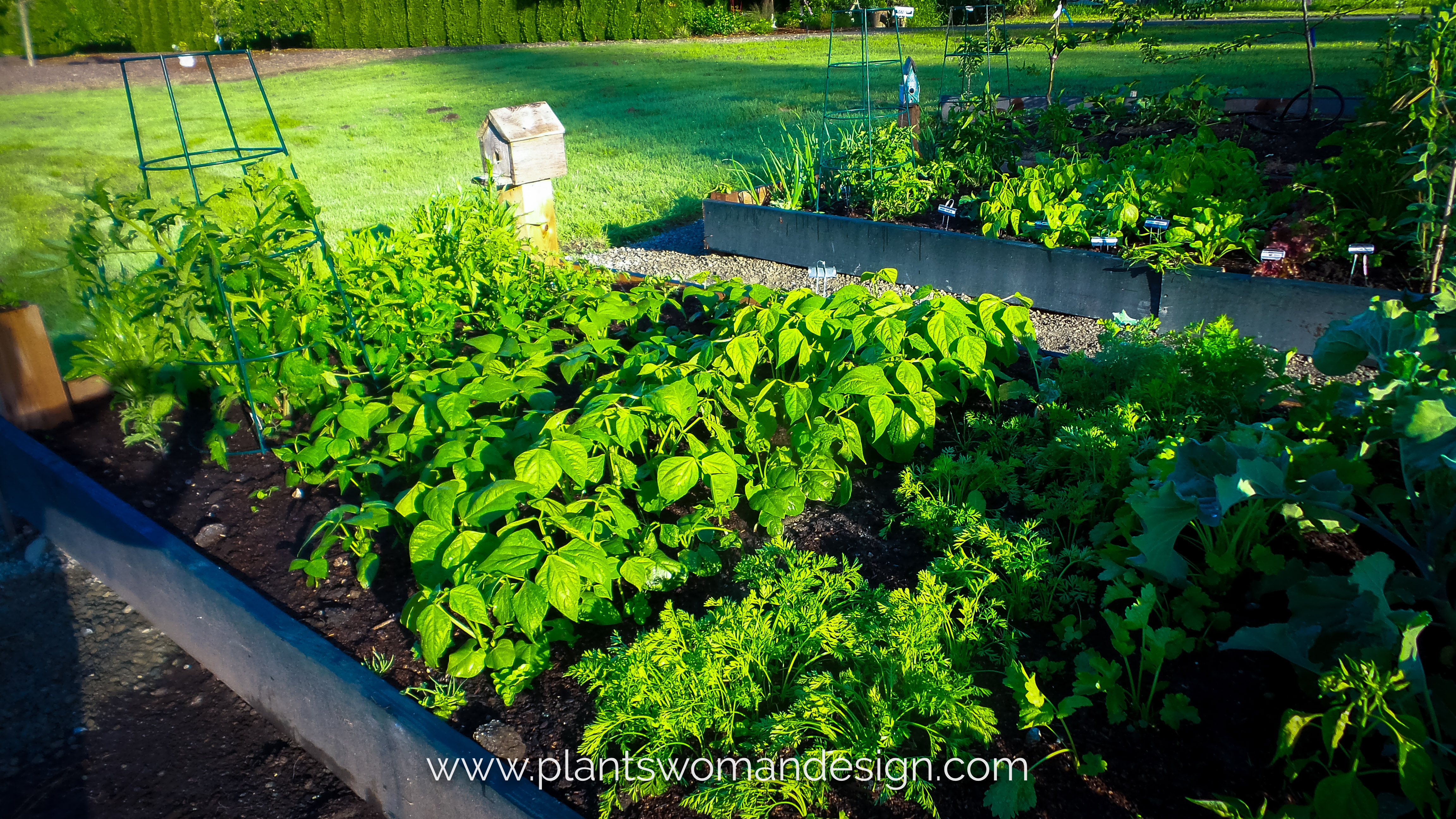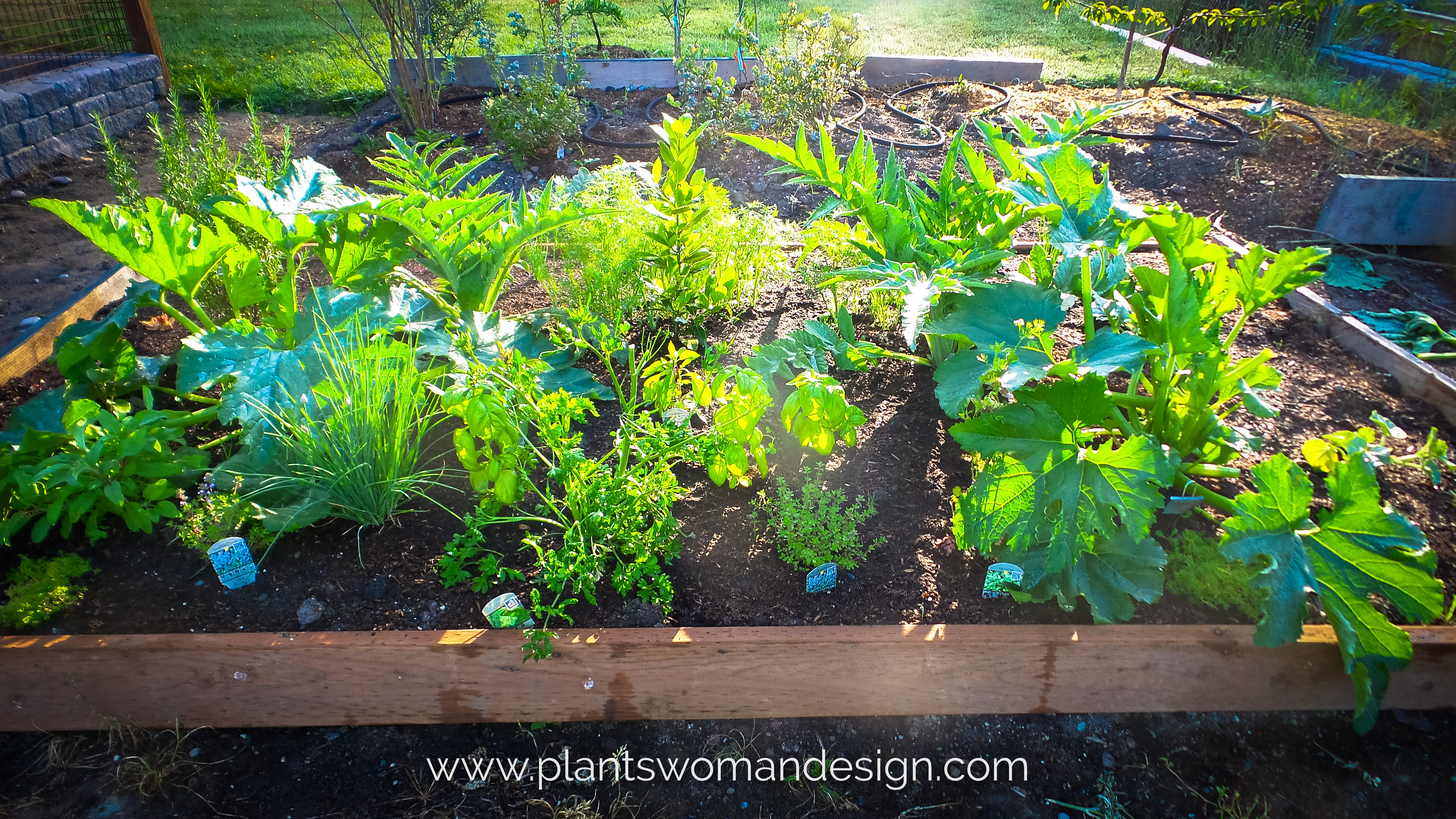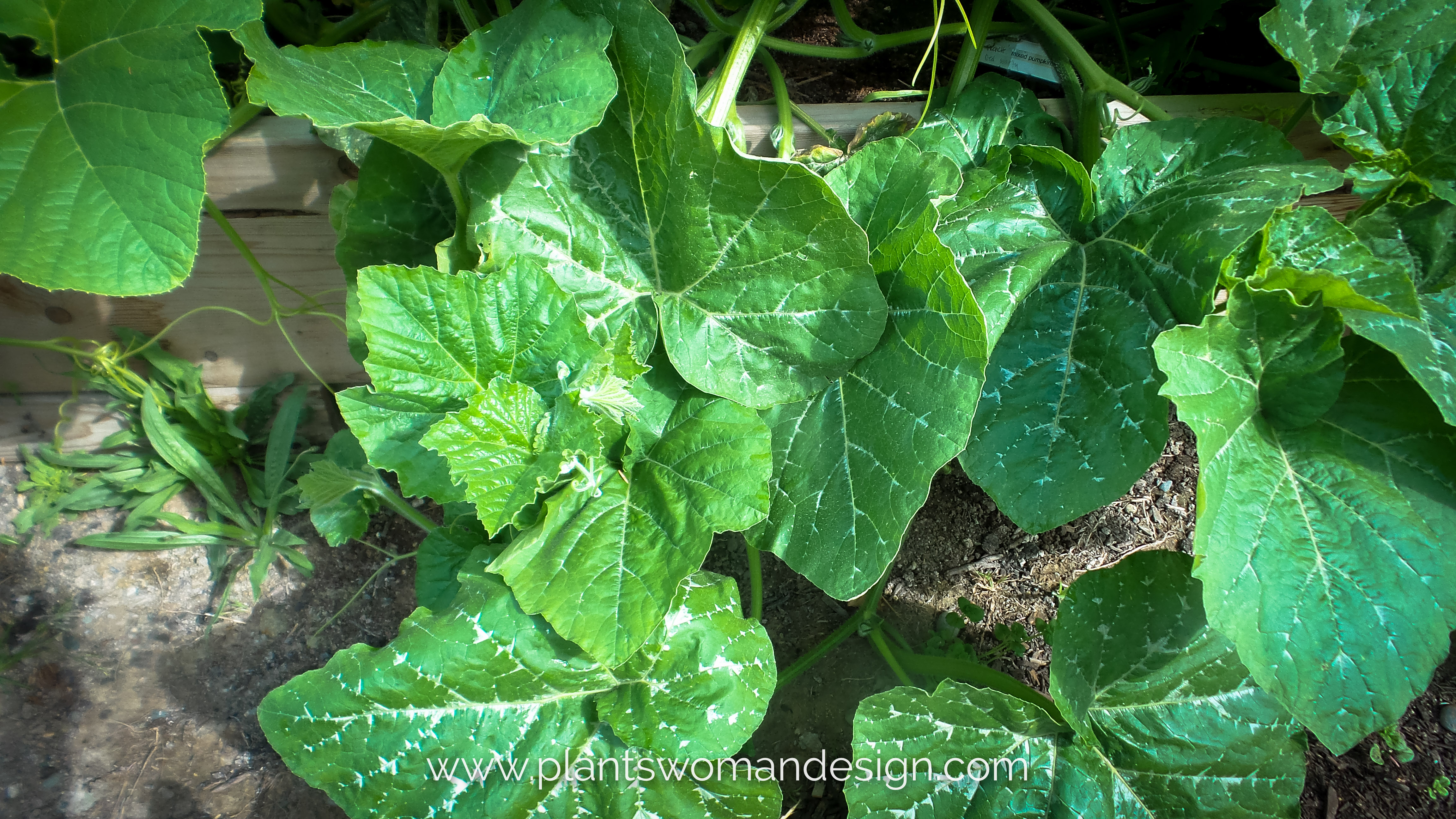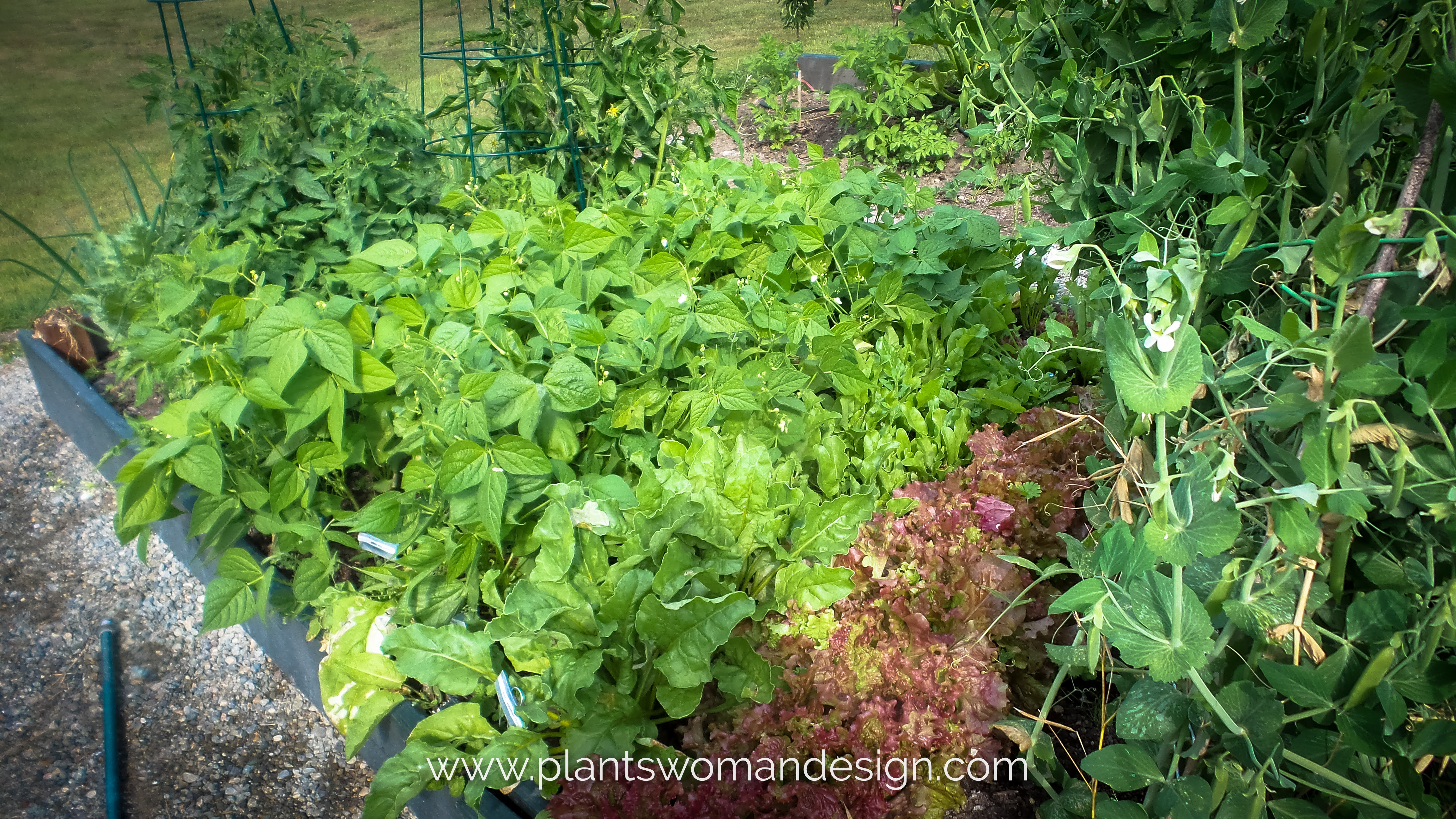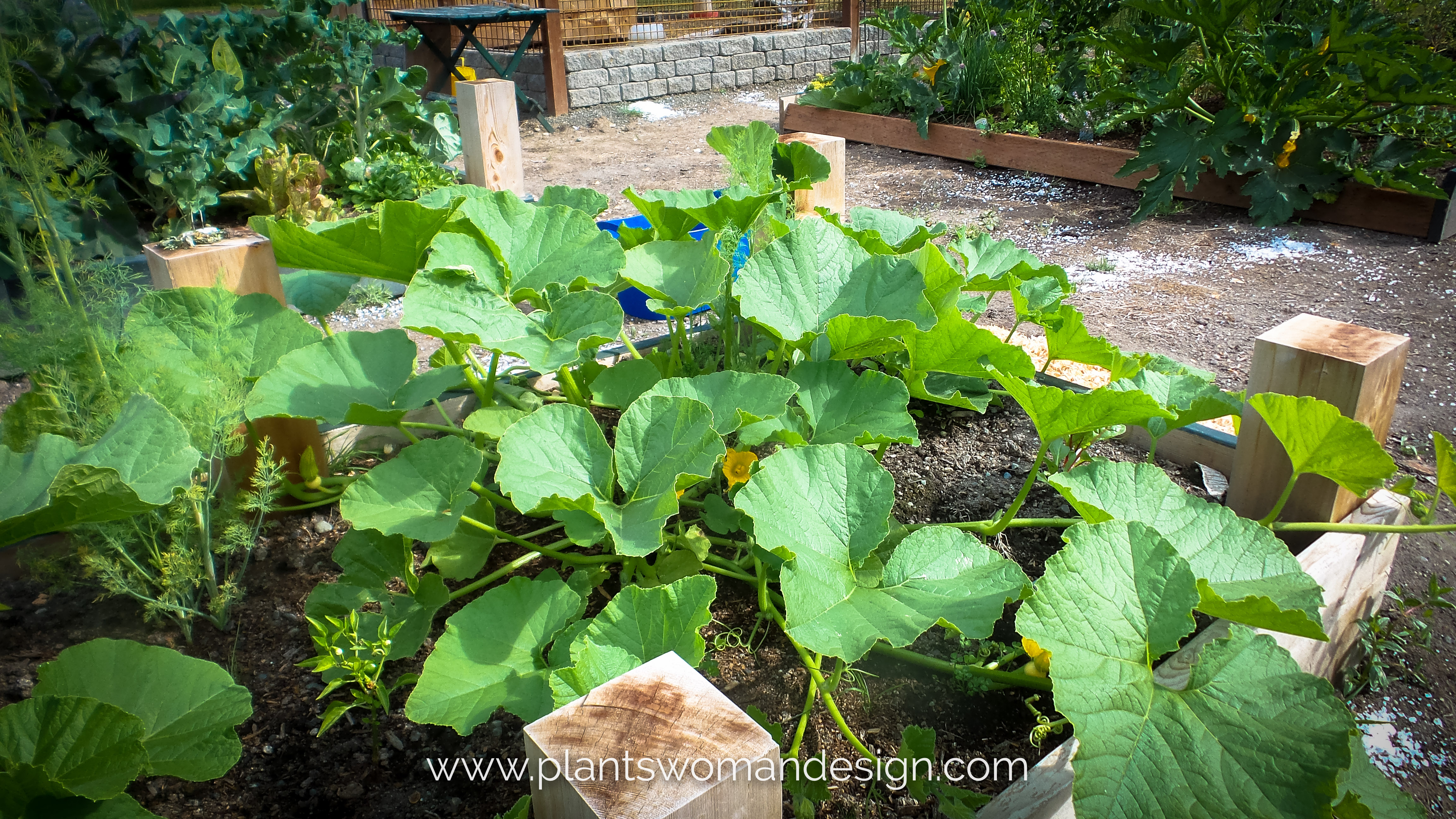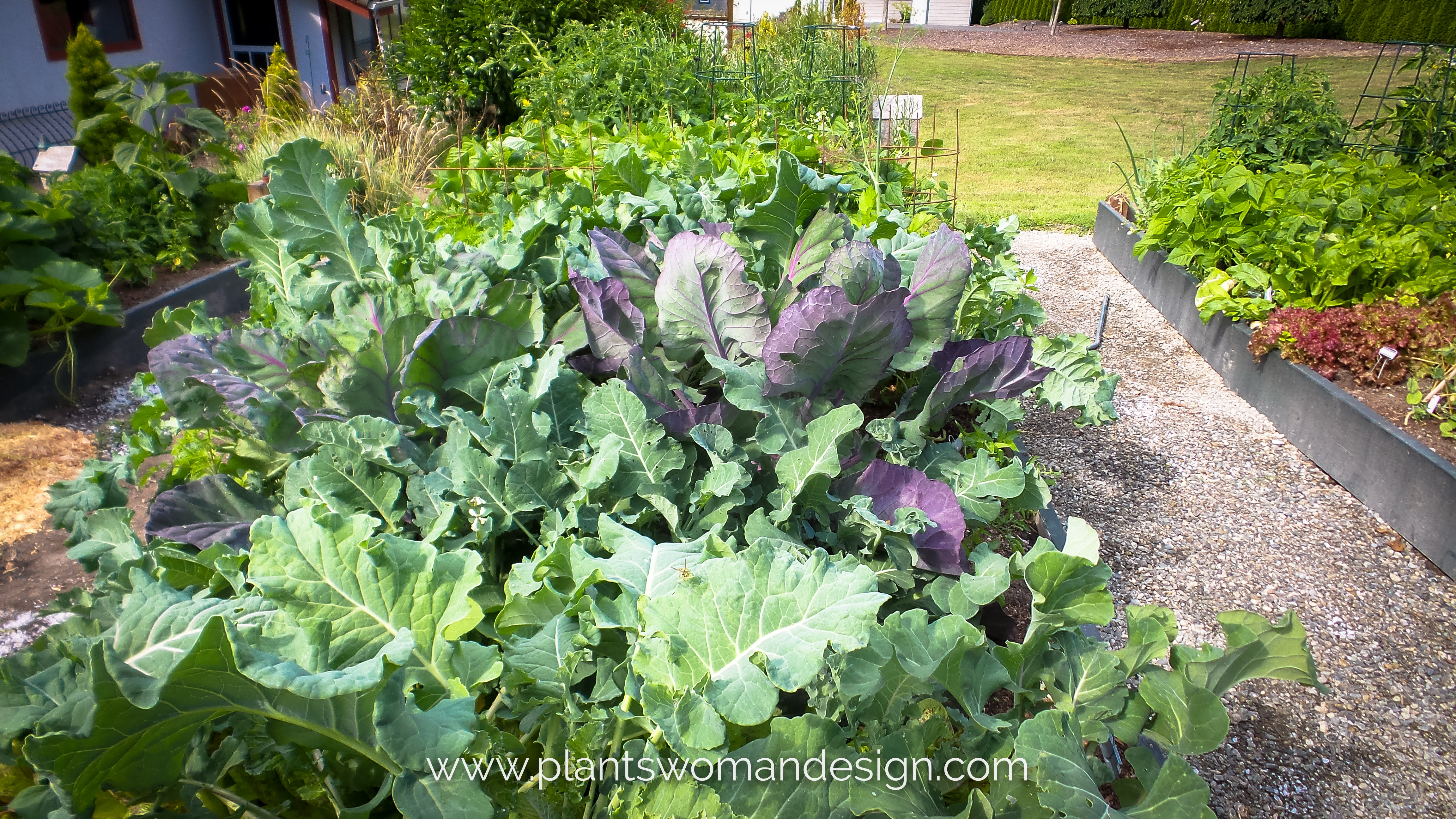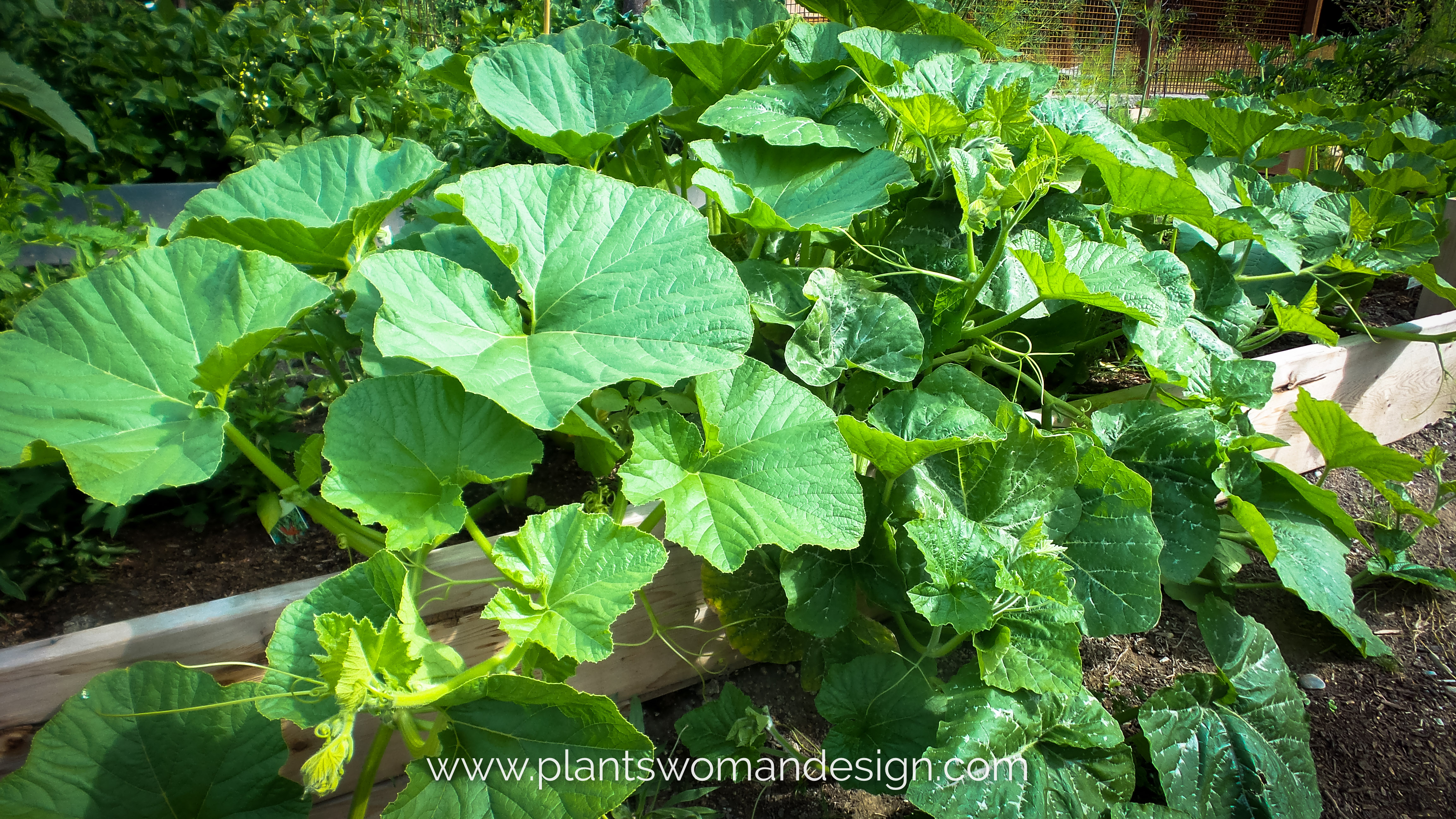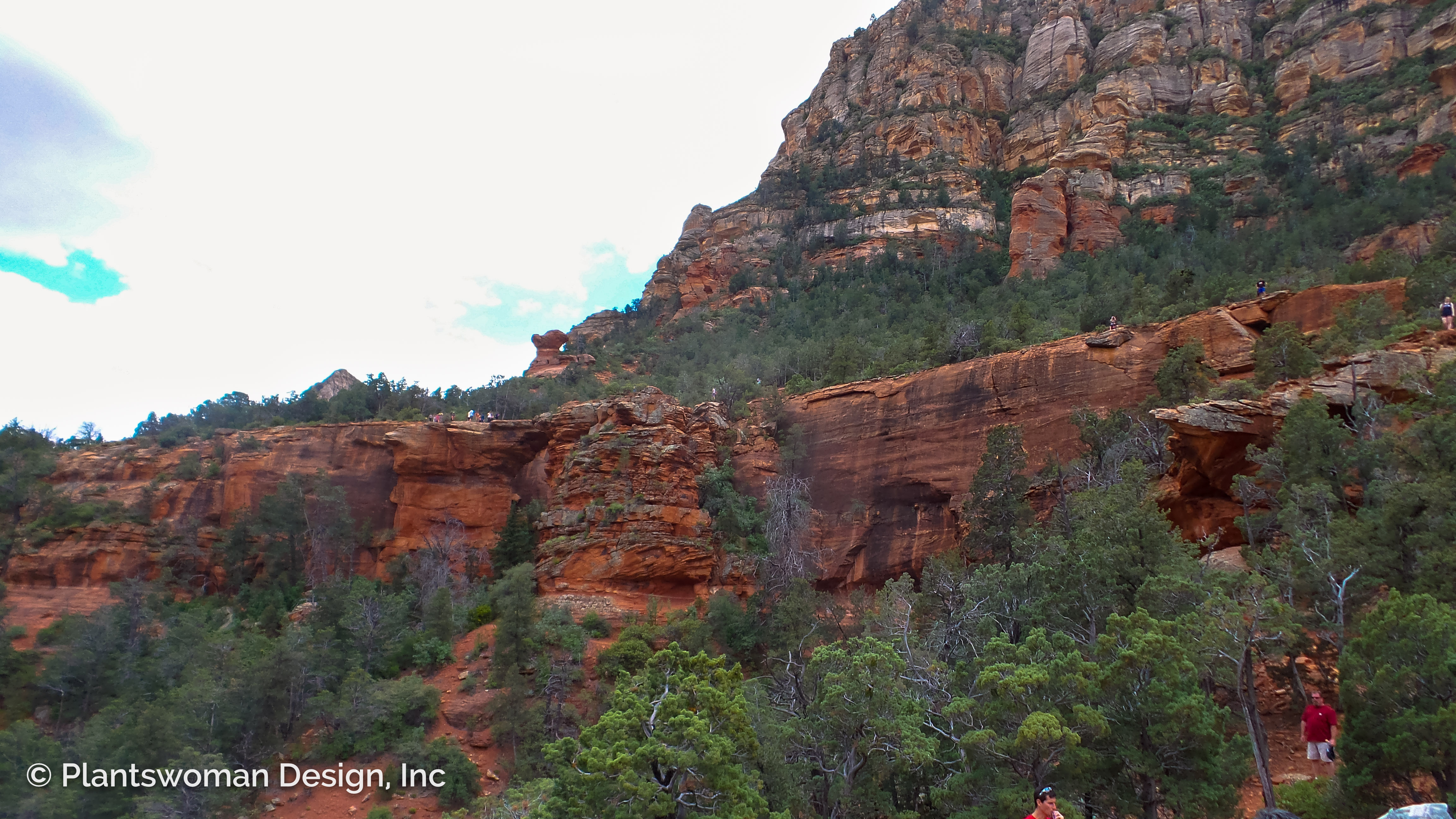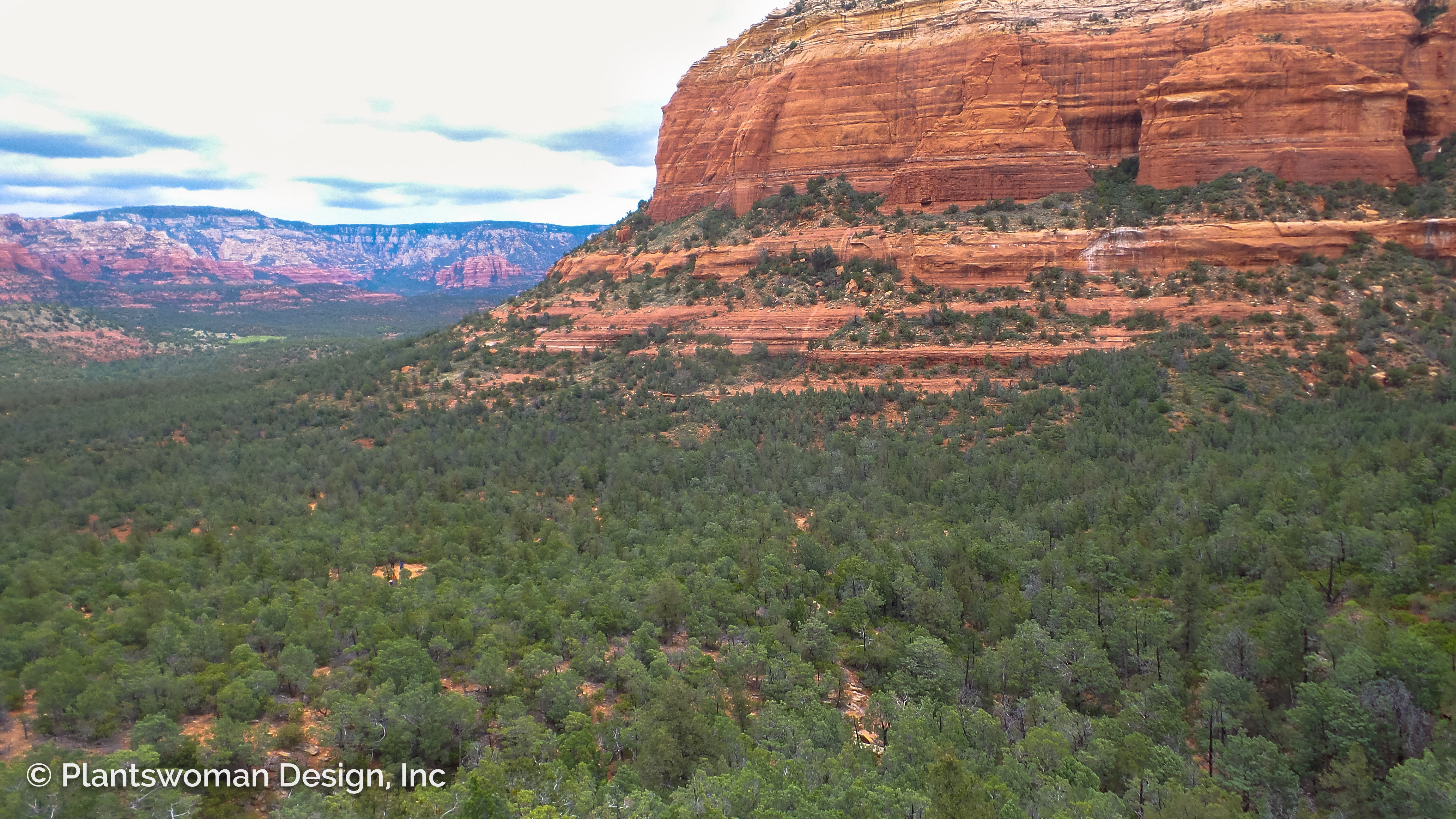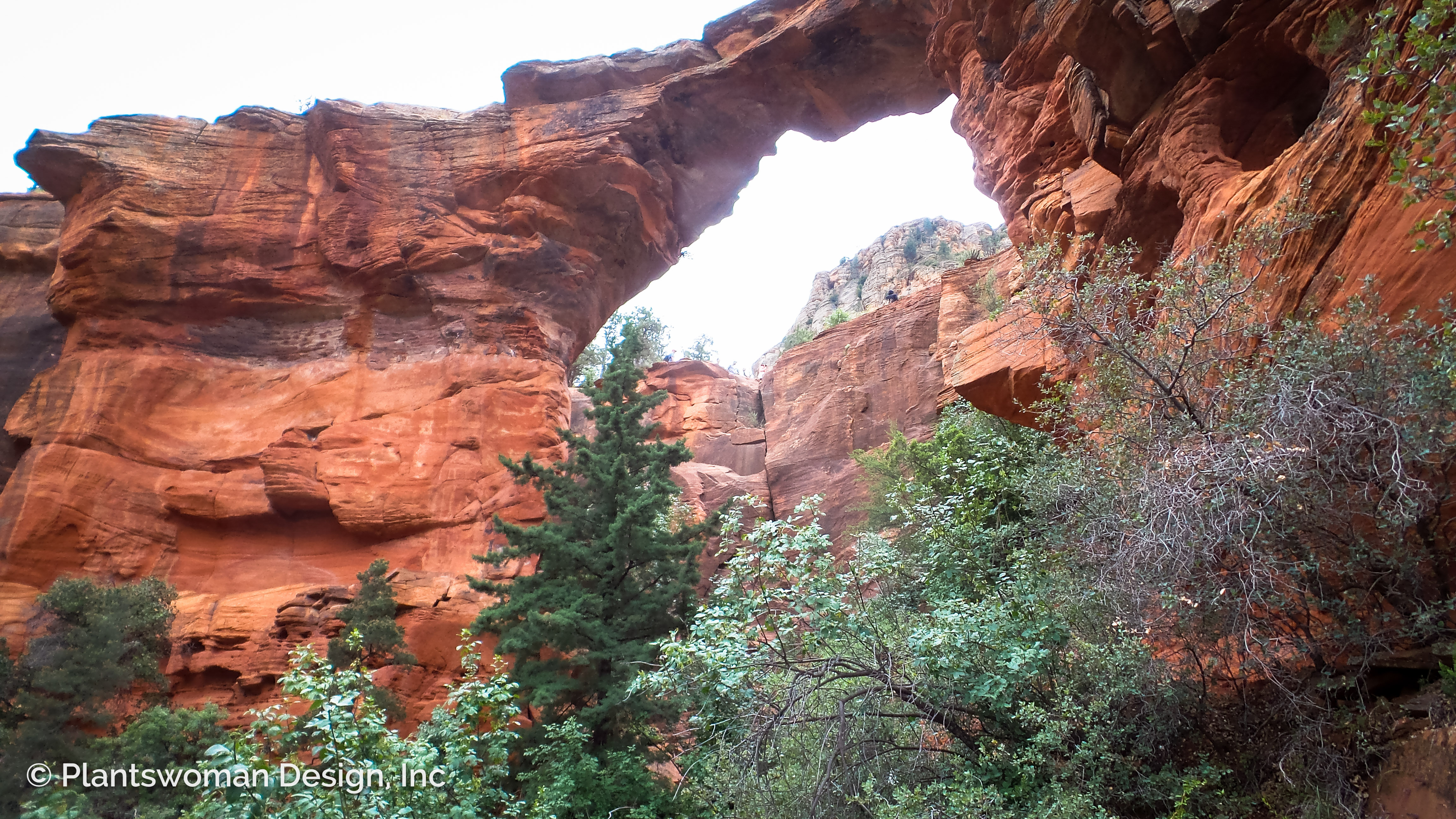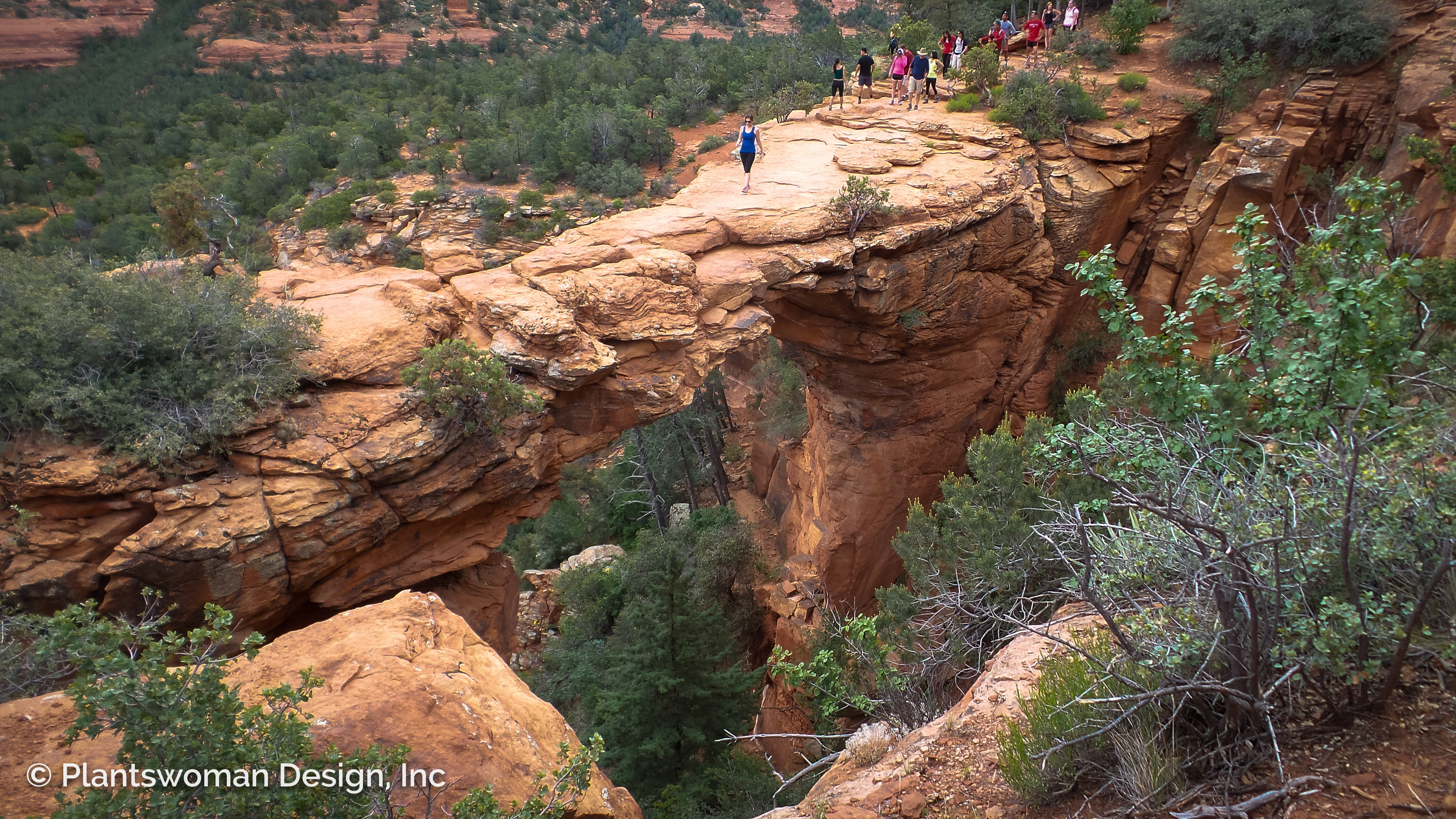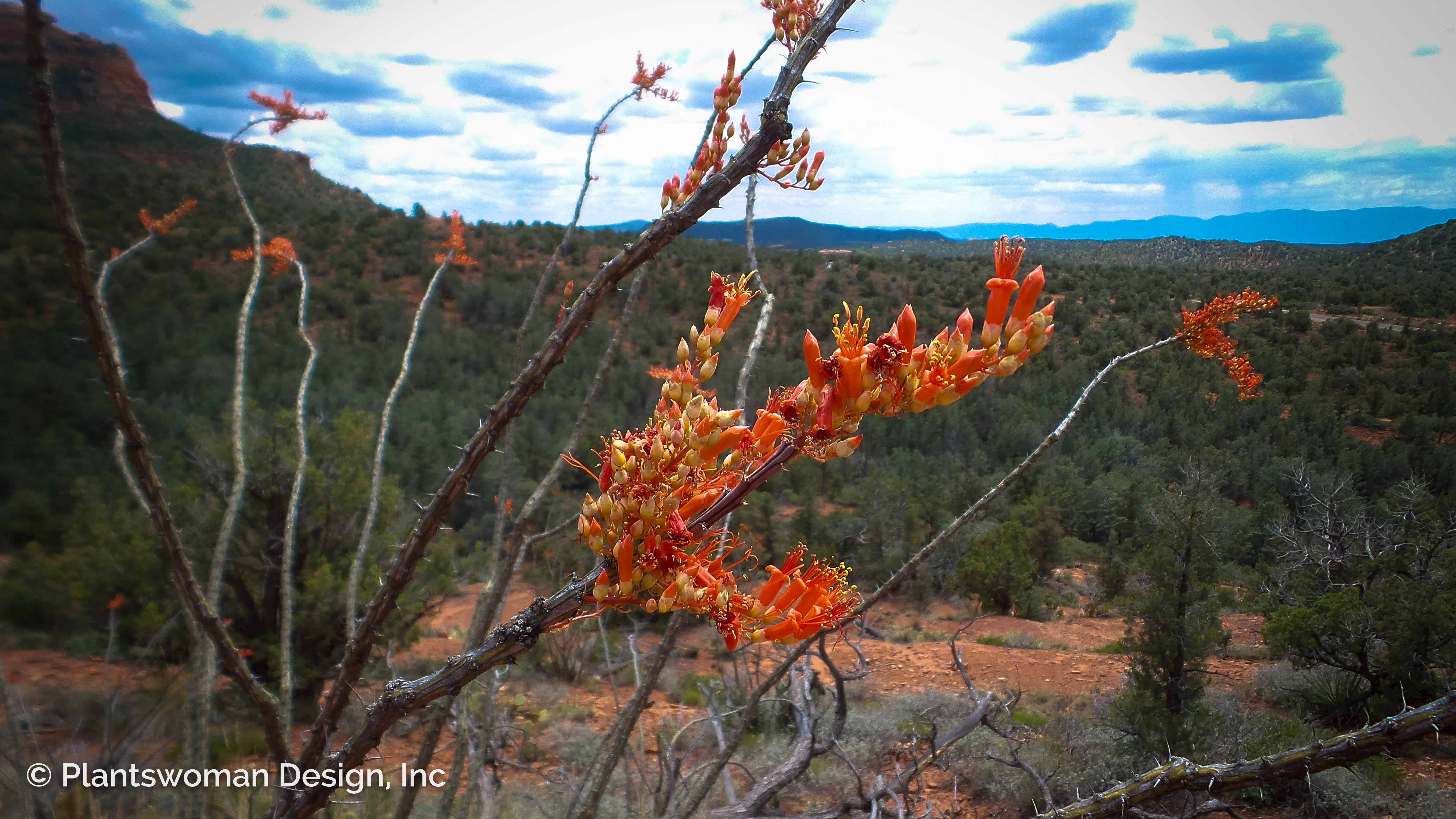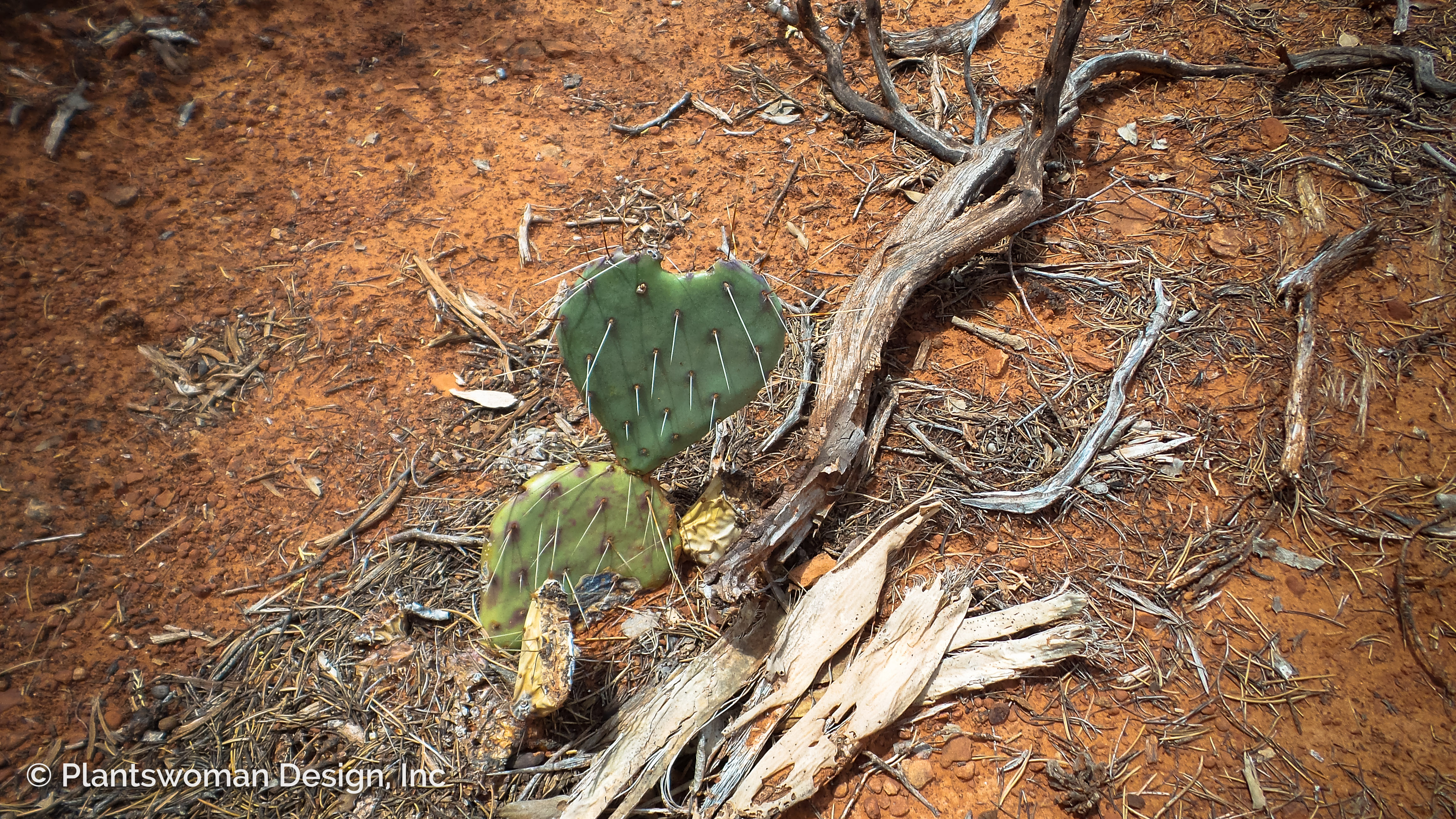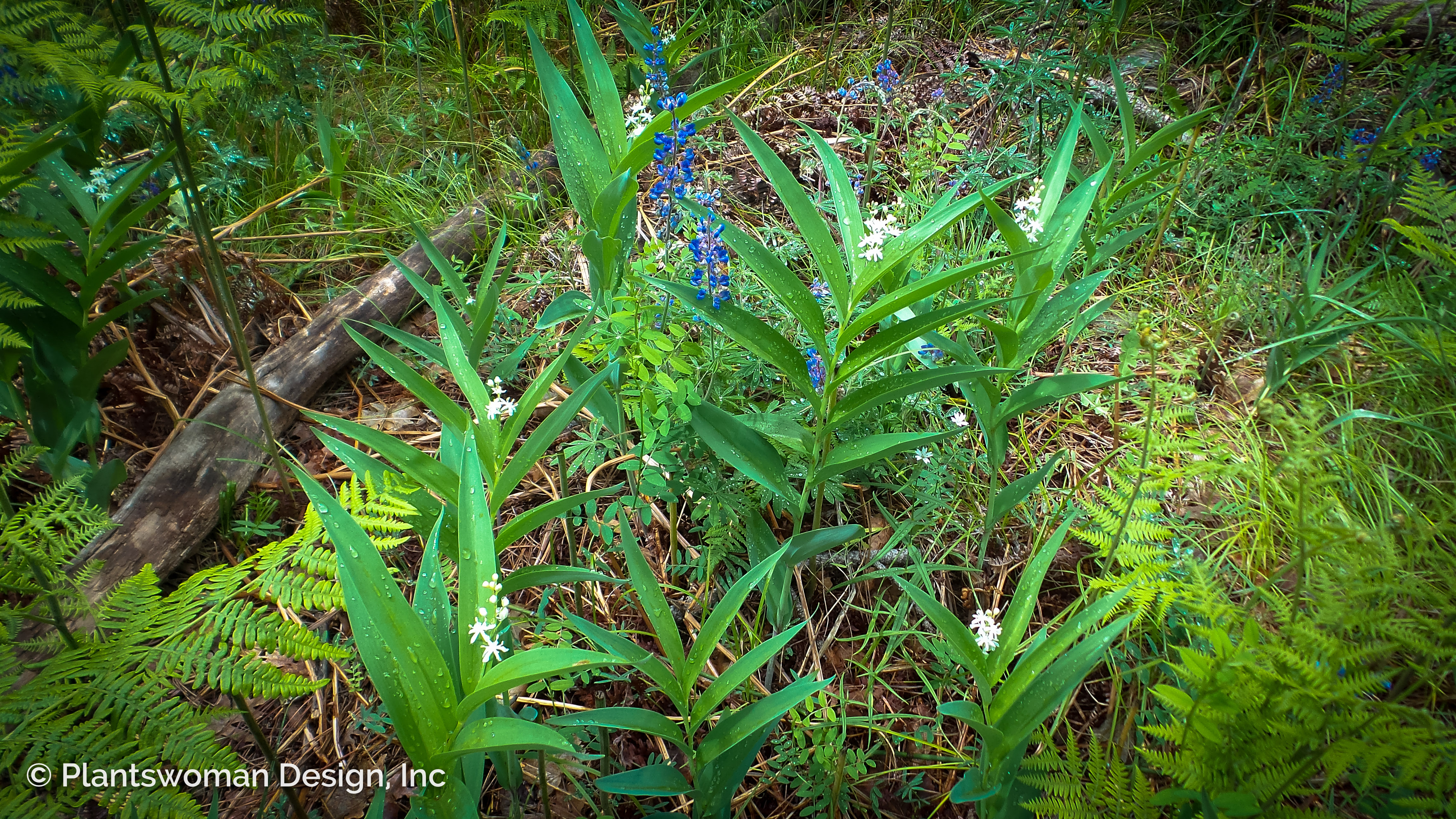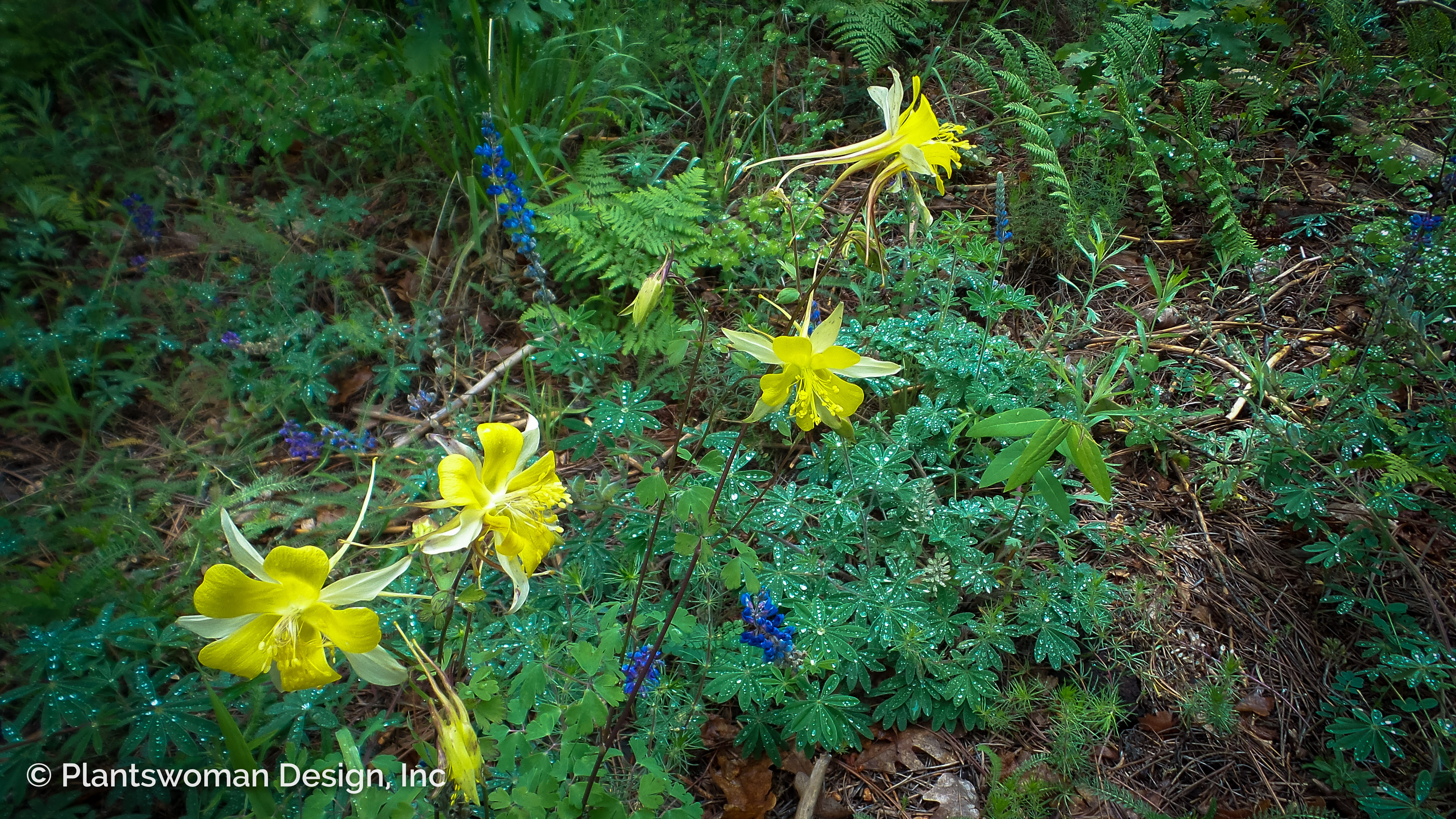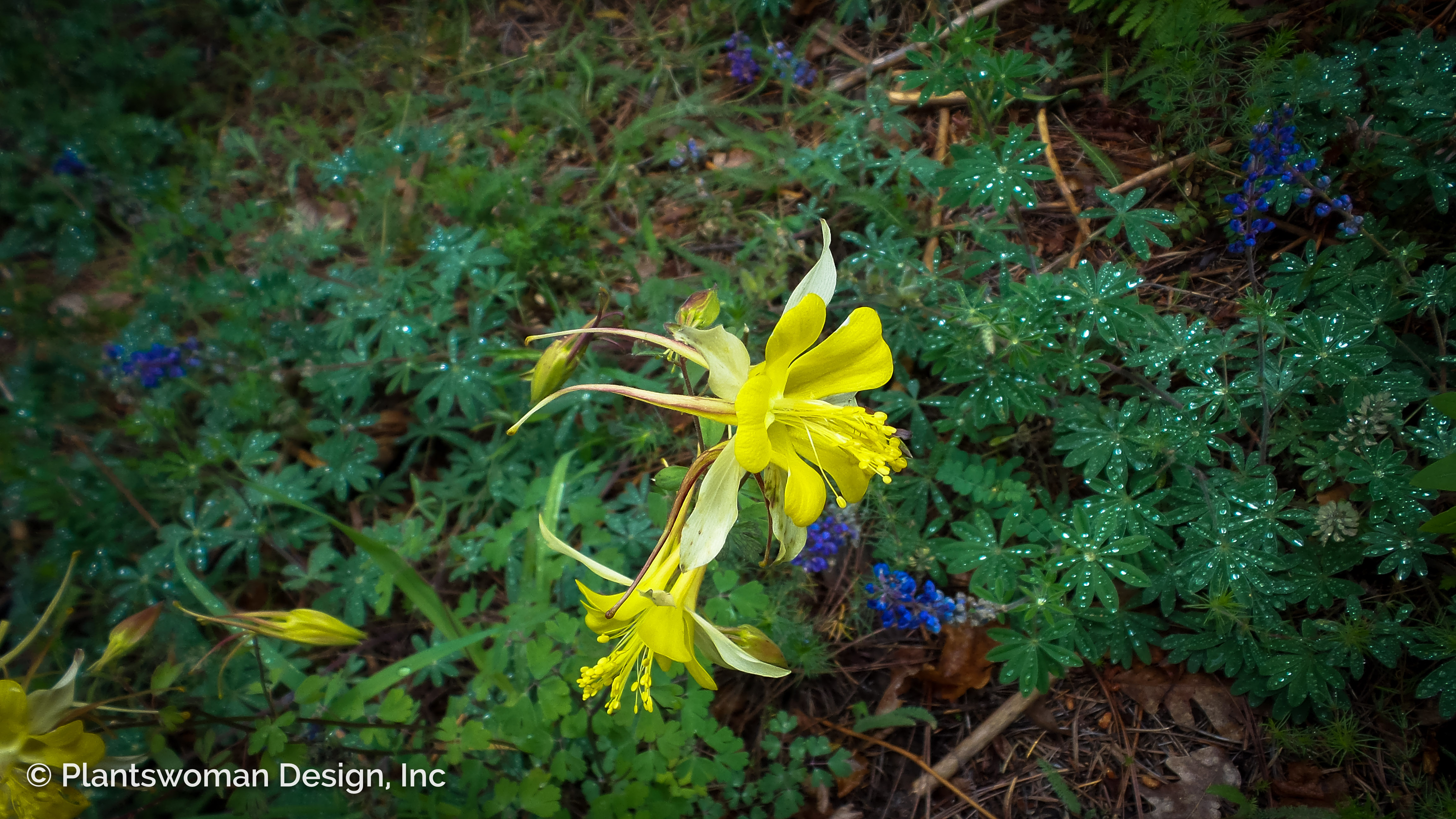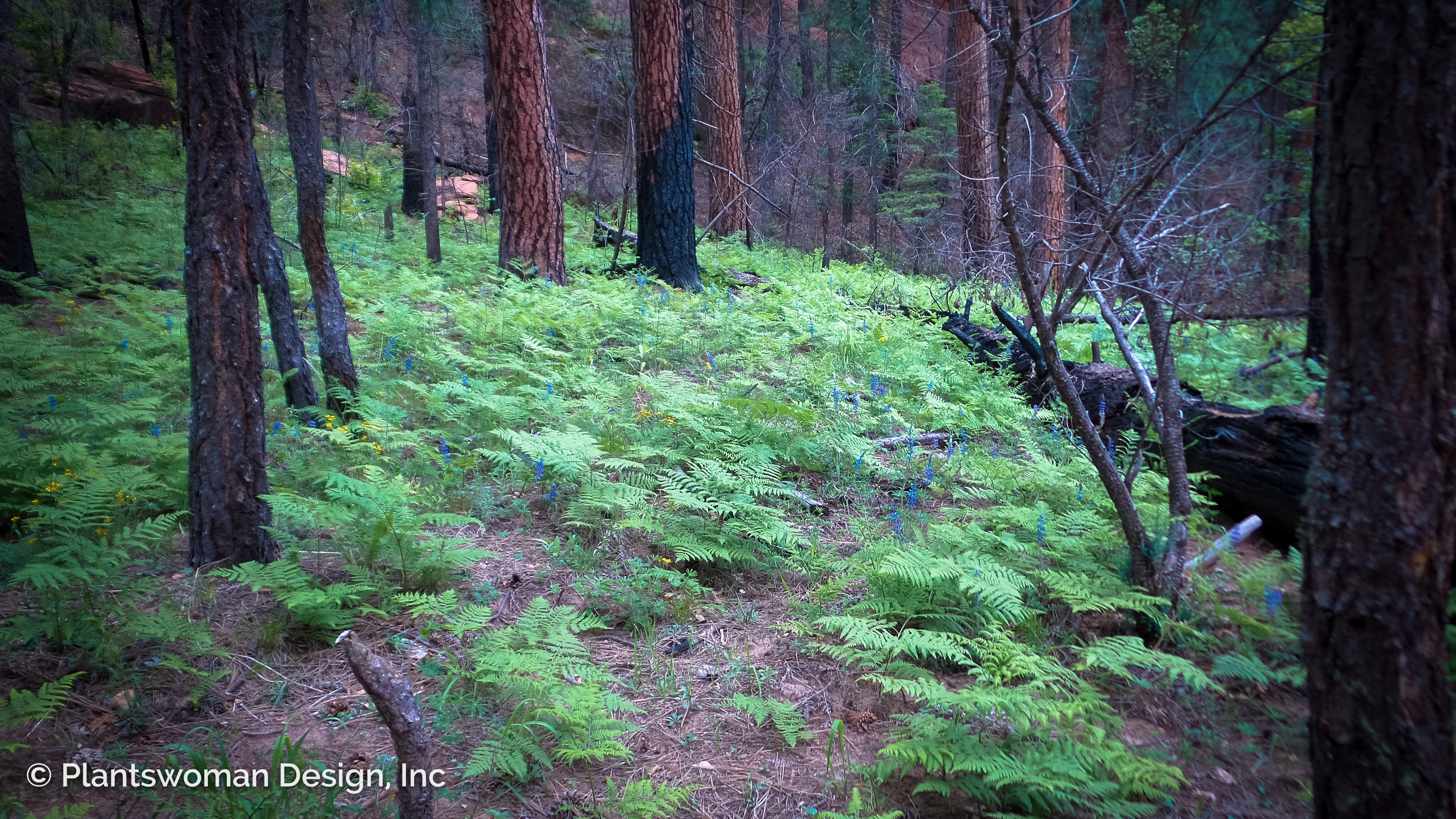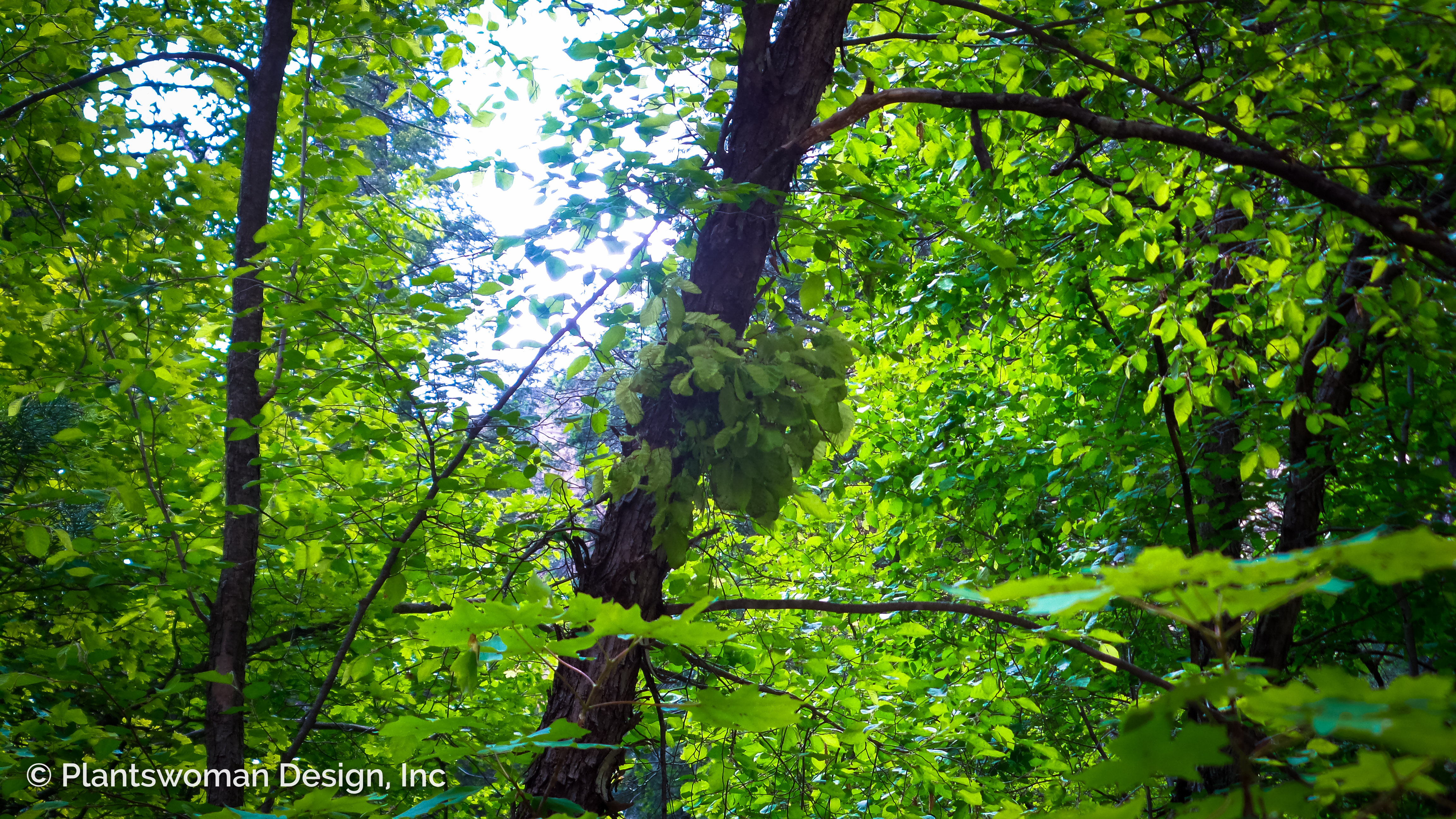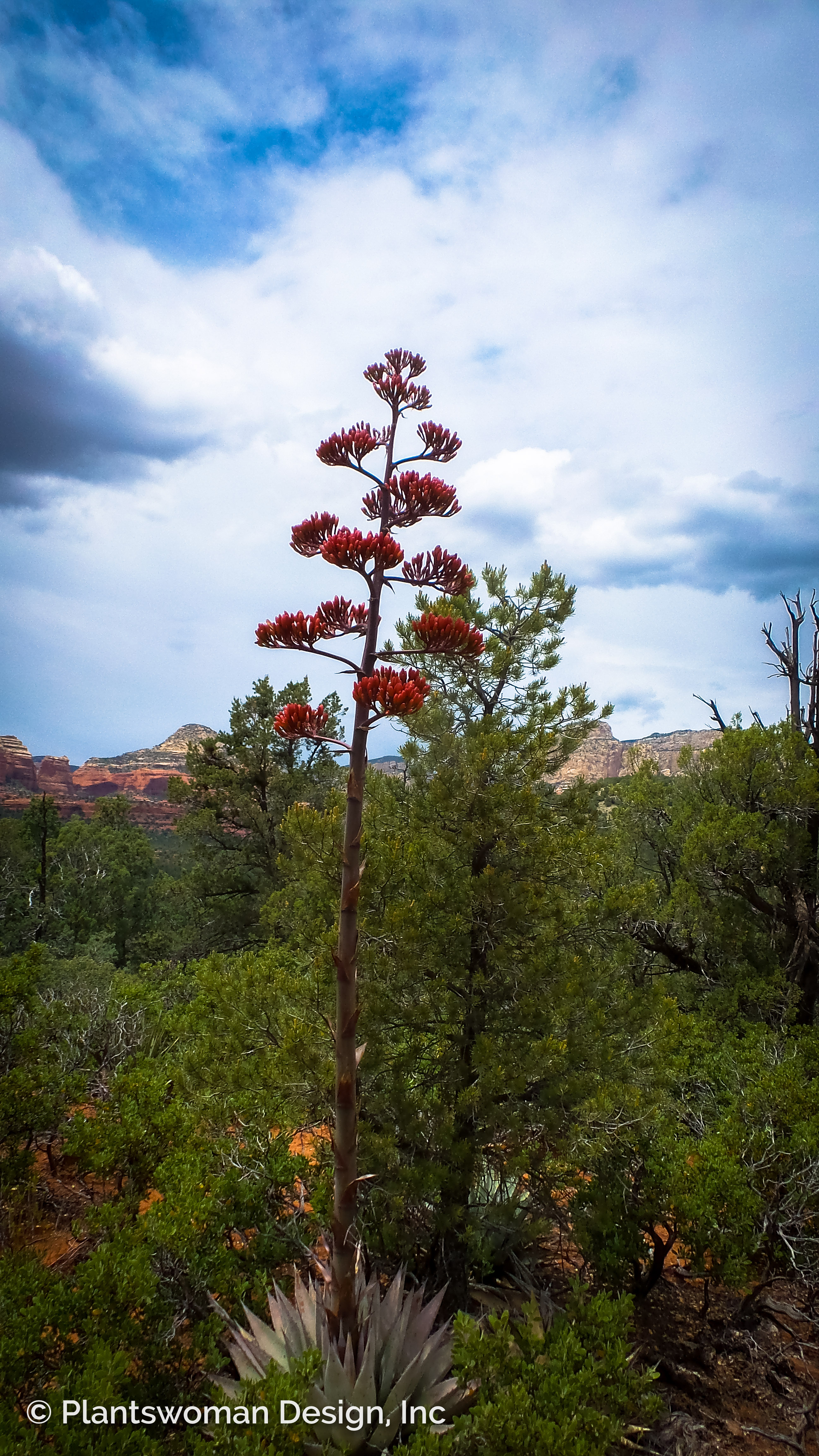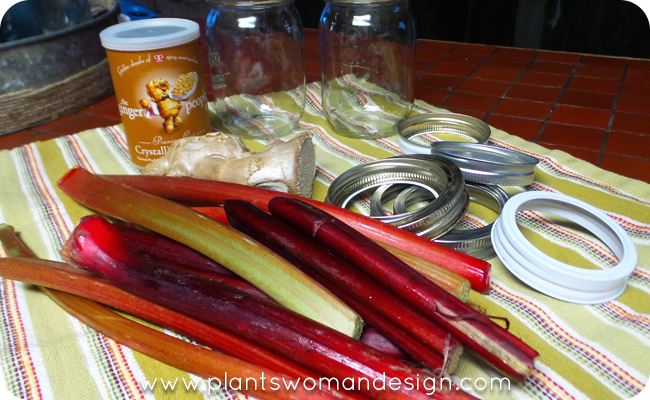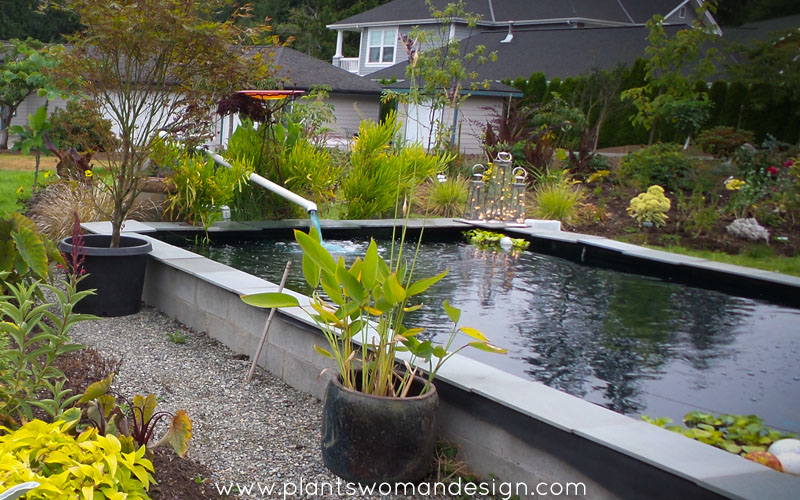
by Susan | Jul 24, 2015 | LB Tutorial: Design Challenge
Gardening is not a static thing but always evolving and changing. Sometimes aspects of the garden present themselves as challenges when least expected. Often planning and planting go hand in hand but situations change and the plan needs to be improved upon.
My Koi Pond is one of those.
The urgency to build the pond and get the Koi moved dictated a position out of the way of possible remodel (planning for the future). It also needed to be close to the house because the Koi are actually pets that need to be related to, fed and even touched. They would not like to be tucked into an out of way place (relational site location). They must also be protected from predators so close monitoring is also essential (practical site location).
One thing that has become important is the need for controlling the algae in the pond. The sun is intense in this open location so the water temperature is warm and the algae love the light and the warm water. There are several ways to handle the algae problem in any pond such as bacterial filters (called bead filters), UV light treatments, and chemical treatments. However, one of the easiest and most effective is shade. By shading the water the light is blocked and water is cooler thus helping to control the growth of algae. The bead filter, UV Filter and chemical treatments are in use but right now the pond is still the color of pea soup and suspended algae is obscuring the fish!
My recent visit to the new garden of Little and Lewis on Bainbridge Island confirmed that shade was probably best solution. They have a small pond with fragrant water lily and pitcher plants (get Botanical name) located in the courtyard with overhanging bamboo, Tasmanian Tree Fern and Abutilon. Crazy non – natives that required protection and a heater in the pond but that also create shade that keeps algae at bay.
The challenge now is how to create lush shade near the Koi Pond without blocking the view to the water. Granted there is a certain aesthetic that can be used in creating the necessary shade and also shaping a more focused view instead of wide-open view. The same principal is seen in tree pruning called ‘limbing up’ in which the gardener trims off lower branches so the focal point is cast between the tree trunks. This gives you a more interesting view by framing it and focusing the eye towards it.
Plantings at the end of the pond will help eventually but will take a while to grow into the actual shade needed to be effective. Here is a first photo of a Japanese maple in position towards the southeast.
This is located in front of the view so it will block some view, and provide shade from the morning sun.
I would love to hear the thoughts of other Gardeners out there. Share your ideas and insights on the Challenge. Here is a layout of the space. Let me know what you think!!
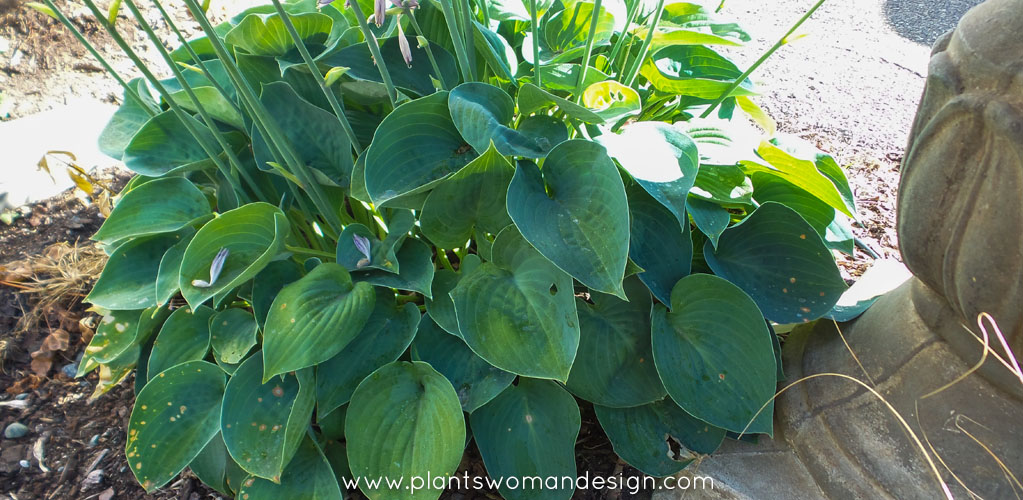
by Susan | Jul 18, 2015 | garden travel
When I get a chance I love to travel, mostly following my kids around in their life adventures. Last week found me in Michigan and I became a little crazed while walking down the street. This is not all that unusual but can be embarrassing for the grandkids. They start tugging my hand and saying ‘It’s ok Gma, let’s go back’. Both in this little town and on the streets of Boston (another kid lives there), there are hostas everywhere! At least I think they are hostas, without the holes and slime it is hard to tell. These are not plants that are loved, cherished and watched constantly. They are growing around telephone poles, in abandoned gardens, around foundations of houses that haven’t seen a gardener in many years.
When I see plant inventories from Plant Delights, Naylor Creek, and other growers with hundreds of hosta varieties I’m always amazed that Hostas are popular at all. Here in Slugville (not the baseball kind), we are hosta challenged. Our dreams of beautiful tropical spears of leaves and wonderful flowers turn into nightmares. We plant, pick slugs, coddle, pick slugs, fertilize, pick slugs, spread slug killer (organic pet and wildlife friendly, if there is such a thing really), put collars around, (slugs crawl over duh), and put gravel mulch around. There is even the beer method where you get dead slimy slugs swimming in beer to dispose of. One gardener I know takes the morning paper out of the plastic bag and picks snails and slugs for the first hour of her day, EVERY DAY. Still the hostas here look like swiss cheese. The little precious baby ones with tiny leaves disappear overnight with out a trace left to mark its passing.
Why is that! Can we trade slugs for fireflies? How about a two for one, slugs and snails for fireflies. How about developing an insect, bird, or animal that loves to eat slugs while leaving the rest of the garden alone. Or maybe a slug that tastes like blueberries so the Robins will be fooled. Here are a couple of pictures of my hosta!
You can see the slug method of cultivation. This is with the pet friendly slug killer around them. Maybe slugs are really pets in disguise. The first photo in this post is one that I inherited with the house growing in an odd place, on an island surrounded by asphalt, planted with gravel and Agaves. That one is safe for the time being. Maybe someday the slugs will find away to get to it. They are sneaky like that.
Hello and welcome! I'm Susan, owner and principal designer of Plantswoman Design. When I'm not designing for others I'm in my own garden growing and experimenting with plants. I want to inspire everyone to grow something. So, join in the conversation and then let's get outside!
PO Box 10505 Bainbridge Island, WA 98110
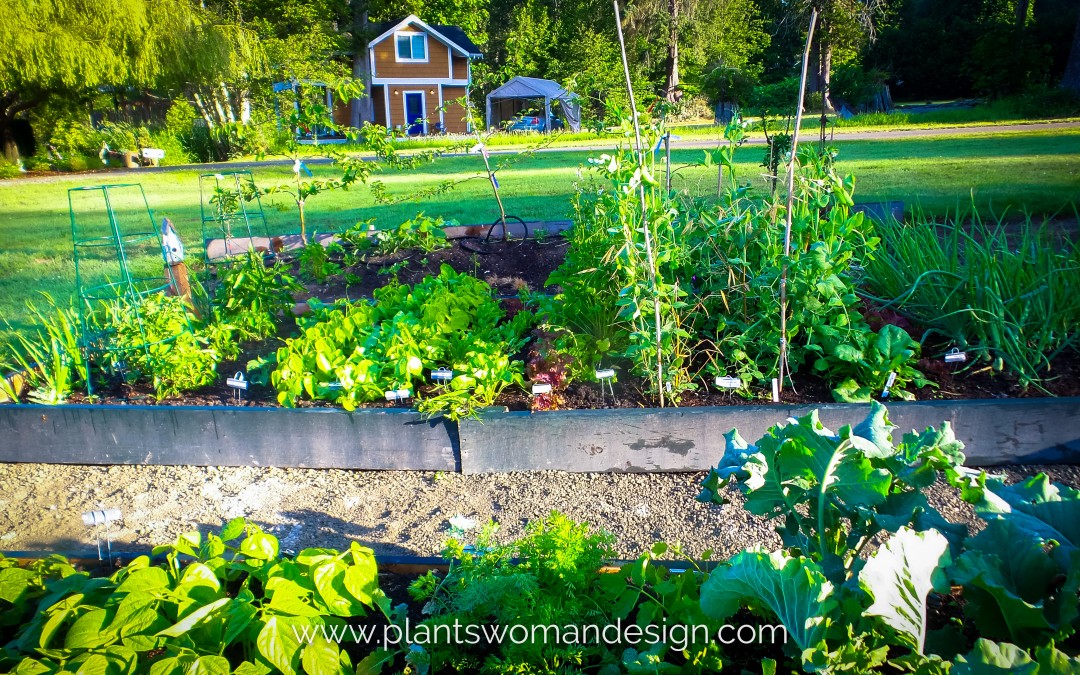
by Susan | Jul 10, 2015 | garden food
If you have been following the blog for the past year you will remember my post from last July (4th of July Garden). I had just moved into my new place the middle of June and could not imagine life without a Veg garden. So, I made one out of recycled concrete forms placed over cardboard with new soil mixture added in. These formed the basis for a fairly good garden. Beans, peas, lettuce, arugula, spinach, and tomatoes did fairly well but the pumpkins were difficult. Very little effort was required after the initial planting. Adding some compost and fertilizers helped the process.
Adding significant square footage this year was so exciting. I expanded the beds and formed them out of recycled timbers and posts. Long, deep beds (6 ft across) made for a good soil mixture. Reusing the soil from the original 4th of July garden I added mushroom compost and chicken manure from the hens. A full 5 yards of additional soil was required and tilled inside the beds. The perimeters were planted with espaliered cherry and pear trees and Columnar Apples. There are plenty of apples on the property but keeping the theme going is important to the designer in me. I love the new cultivars of Blueberry Peach sorbet, Blueberry Bountiful Blue and Raspberry Shortcake so finding them room as test plants was important. ( Kristen maybe these would be a good side bar with links to monrovias website?) Rhubarb from my old garden and some from my Mom are a nod to garden history.
Here is a visual of the garden this 4th of July. Quite a difference I think.
Part of the thrill of gardening for me is the chance to learn, improve, and nurture. It is a never-ending source of delight to try something new, to give a struggling plant a chance, and to enjoy the fruits of your labor.
What is it that keeps you excited about gardening? What are you trying that is new?
Click for more information on the new cultivars I mentioned above…
Hello and welcome! I'm Susan, owner and principal designer of Plantswoman Design. When I'm not designing for others I'm in my own garden growing and experimenting with plants. I want to inspire everyone to grow something. So, join in the conversation and then let's get outside!
PO Box 10505 Bainbridge Island, WA 98110
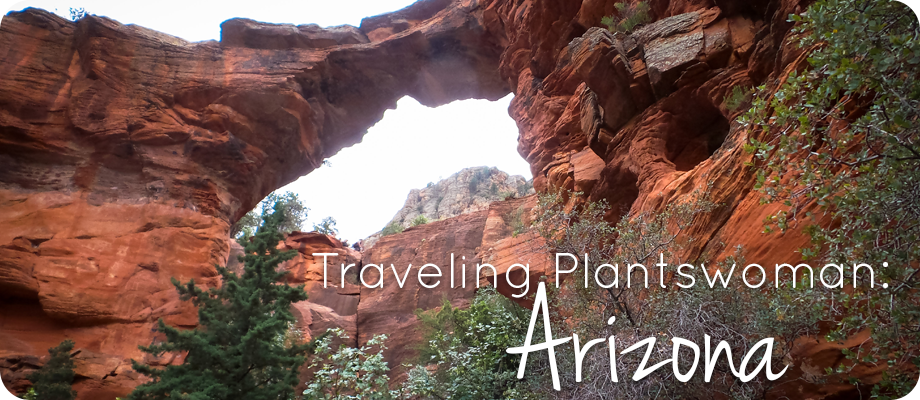
by Susan | Jul 3, 2015 | Traveling Plantswoman
It’s nice to get away from the Pacific Northwest in the spring. Sometimes you can count on a beautiful Memorial Day but usually it will rain and this year was no exception. Lots of rain but not for me as I was in Phoenix visiting family, a great place to visit this time of year. Not hot yet, a mild 70 – 80 degrees, which is not hot even by our standards. Surrounded by friends and family, I usually force them into a visit to a botanical garden or other horticultural activity. This time I was content to go with the general votes as to activity and not force others into seemingly endless views of plants and flowers. We drove to Sedona and went on two great hikes. I was usually at the end of the line of 6 hurrying to catch up after taking pictures.
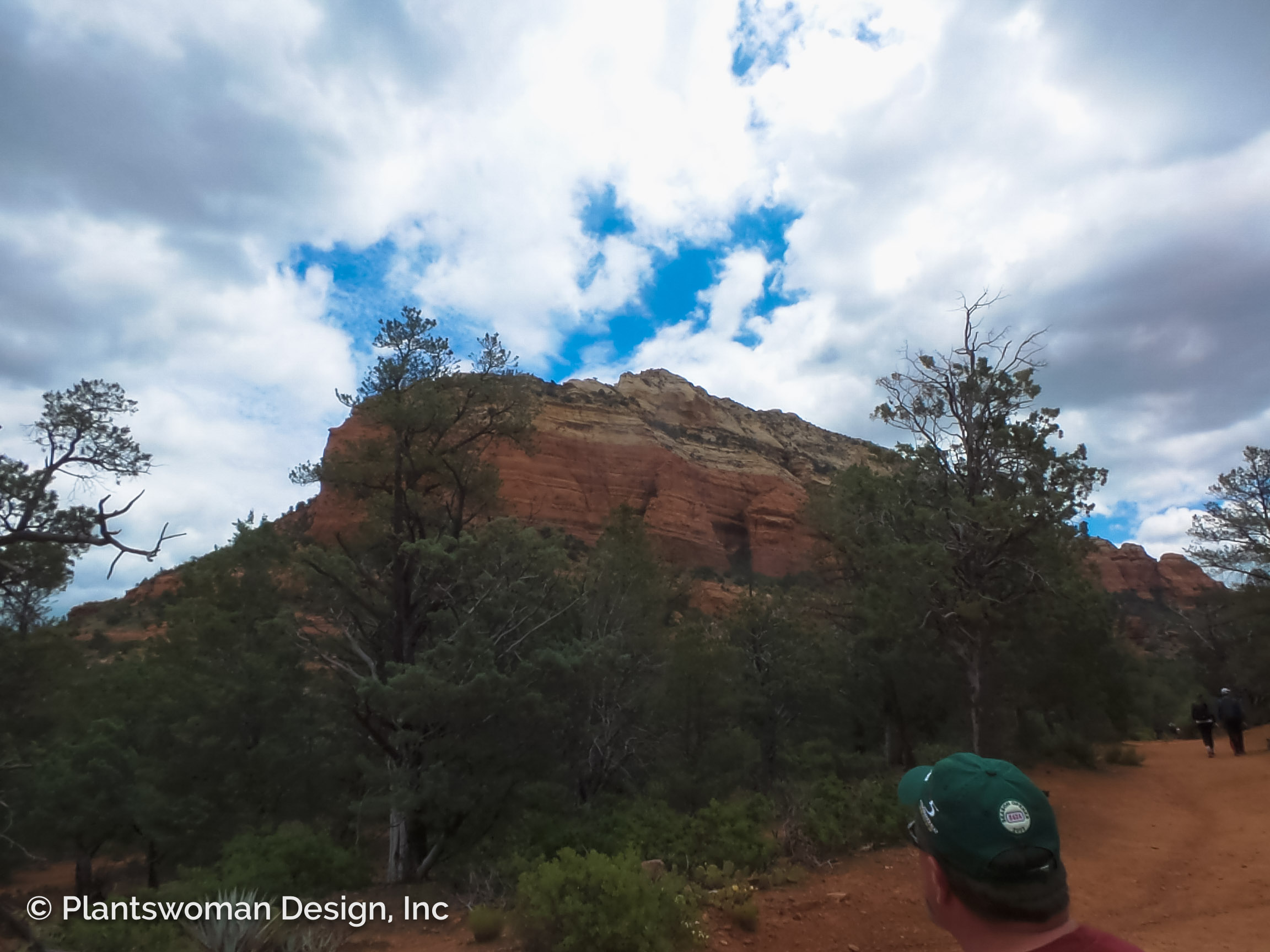
This May has seen a lot of rain in the Phoenix area as well. The hills surrounding the city are sage green instead of various shades of brown. The first day we hiked to Devil’s Bridge, which is a fascinating upper desert hike. Cactus, Oxanix, Yucca, were blooming as expected but what I did not expect was the amazing variety of wildflowers in the sand and gravel. The trail was dry and dusty but alongside were blooming daisy, pennstemon, grasses, yellow lineanara, a light purple thistle/centura, and MANY things I did not recognize. I stopped again and again taking pictures and will continue to do research on varieties found there. Some of them looked very similar to the New Zealand plants that are very popular in nurseries for our Mediterranean climate. Several trees, including varieties of Pines, and deciduous lovely green leaved trees lined the trail. But one of the standouts for me (hater of Juniper) was the colorful juniper with beautiful multi-colored bark. Looking similar to the Eucalyptus trees we found in Hawaii, I would have never expected to love them. The sage green coniferous foliage was a great contrast to the bark. It felt like I was walking through a botanical garden with a very natural design. The grasses massed together naturally and the bright spots of color stood out against the contrast of rocks and gravel.
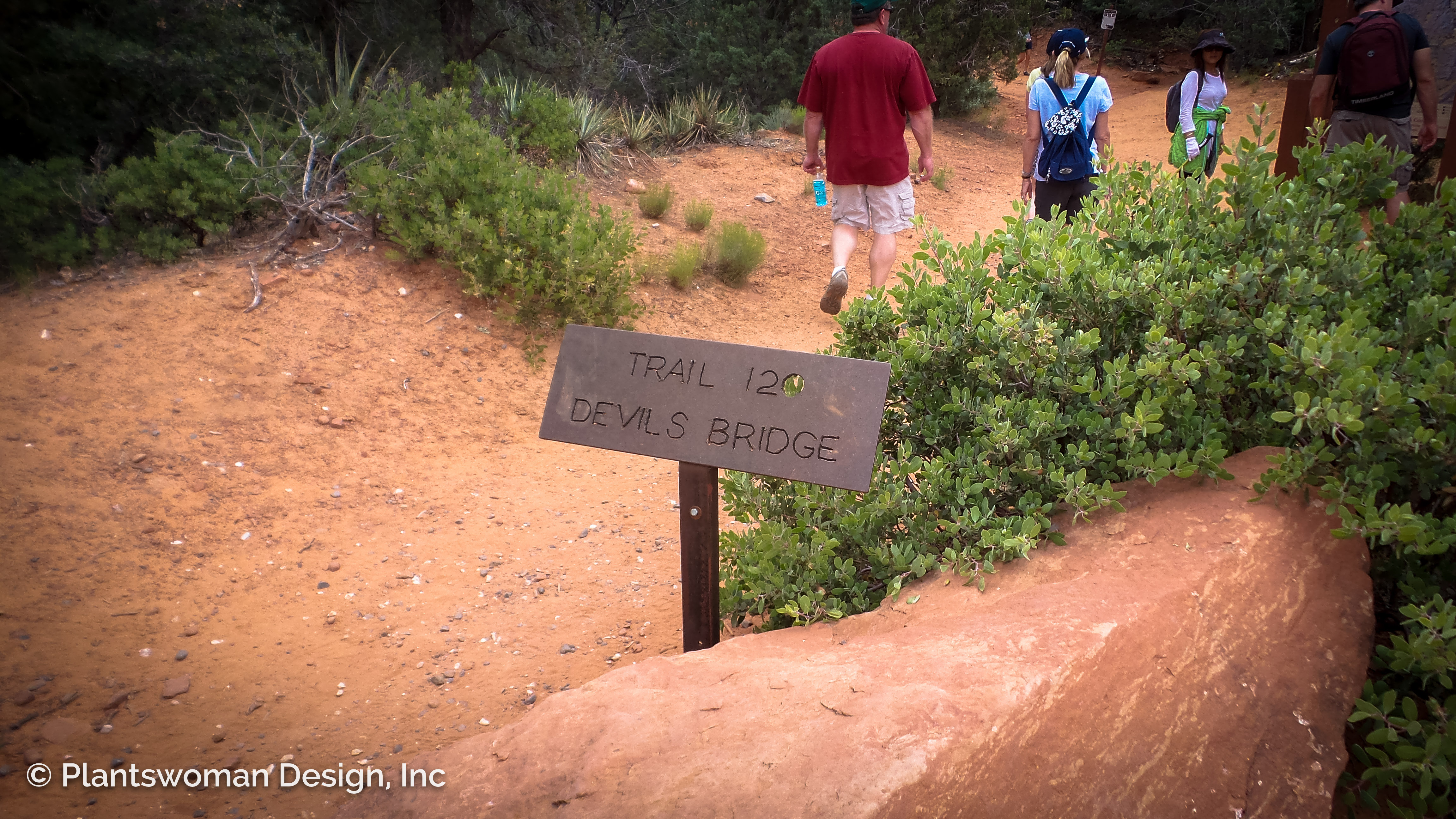
Smooth, beautifully worn large pieces of sandstone were crossed and you could see were flash flooding or old streambeds created washes, and collections of rocks along the edges of the trail.
Air was fresh and scented with sages and the juniper. I know I’m writing mostly about the plants but the rock formation of Devil’s Bridge was amazing too.
After spending time in the dry desert of Sedona on one day we decided to visit the river the next. There is a lovely hike along the river, just a short distance away. The two areas could not have been more different. It was cooler, shaded, with an unexpected lushness. The plants were different with subtle color and texture. Ferns! Yes ferns growing under the larger trees.
The trail meanders along the river with 12 crossings with sandstone under foot was easy too walk on. If you happened to slip and fall in the water it just felt great. As we went up river the sides of the valley became steeper and the rock formations towered over us. A cool spot for a picnic lunch then back along the river back to the parking lot. Cool drinks awaited us when we got back to the cars. Such a great hike!
Interested in creating a more natural look and feel in your own garden? Take a look below.
DESIGN TIPS – Natural garden design means grouping many of the same type of plant together, interspersing the next grouping of plants and blending the edges into the next grouping of like plants. Carefully observing and copying what you see in nature helps in creating a natural style bed.
Hello and welcome! I'm Susan, owner and principal designer of Plantswoman Design. When I'm not designing for others I'm in my own garden growing and experimenting with plants. I want to inspire everyone to grow something. So, join in the conversation and then let's get outside!
PO Box 10505 Bainbridge Island, WA 98110
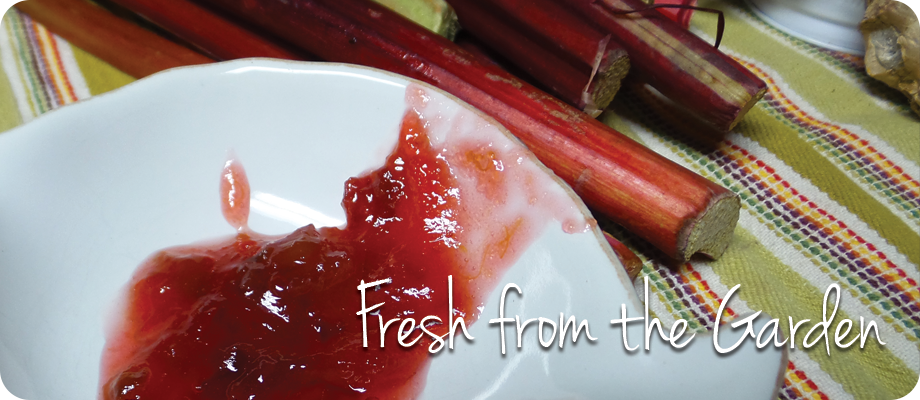
by Susan | Jun 19, 2015 | garden food, LB Tutorial: Recipes
This time of year Rhubarb is at it’s peak. I love many things rhubarb and Rhubarb Ginger Jam is high on the list. This wonderful jam preserves this flavor into the fall and winter when you are craving rhubarb. It is wonderful on Ginger Scones with butter and clotted cream.
This recipe calls for forced rhubarb, which is pink not green and red. But I have used fresh picked rhubarb from my garden and it is great although not as pretty as the forced type would be.
Establishing Rhubarb can be a little tricky. Once it is established it is very tough. This year I put in two plants, one ‘cherry ripe’ and another that is just the regular variety. The regular cultivar is doing ok and the Cherry ripe looks dead. When I was at the nursery today their potted plants looked just as bad.
Make sure that the plant has a slightly solid soil with good nutrients. Add some compost and keep well watered. Beware of fast draining soil rhubarb is not a fan.
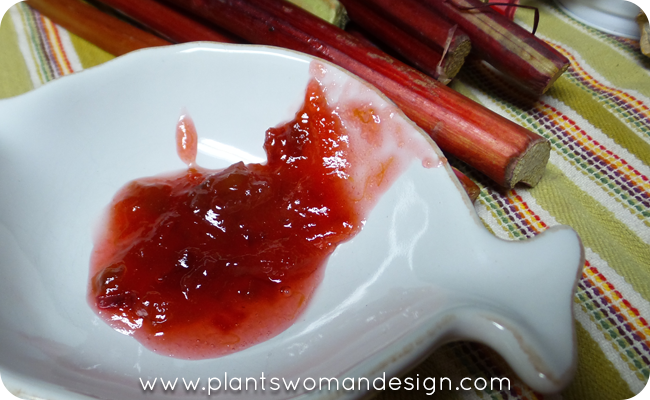
Rhubarb and Ginger Jam (adapted from Good Food magazine)
1 kg/2 lb 4 oz pink rhubarb trimmed weight
1kg/2lb 4 oz Sugar
1 box fruit pectin
Juice of 1 lemon and zest
2 oz crystallized ginger, finely chopped
4 cm piece of ginger, peeled
Wash rhubarb and slice into small pieces. Place into a large plastic bowl and add sugar, pectin, lemon, and chopped crystallized ginger. Finely grate peeled ginger directly over rhubarb.
Stir it thoroughly and cover with cling film and leave for about 2 hrs to allow the sugar to dissolve in the rhubarb juices. Stir it occasionally to encourage this process.

Pop a few small plates in the freezer. Put the mixture into a large pan, and set over a medium heat. Stir until the sugar has completely dissolved, and bring to a boil. Continue to cook at a fairly swift pace until the rhubarb is really tender and conserve has reached the setting point, about 10 -15 mins.
To test for a set drop ½ tsp of the jam onto a cold saucer, leave it for 30 secs. Then gently push it with the tip of your finger. If the jam wrinkles the setting point is reached. If not, continue to cook a couple of minutes more and test again.
Remove the pan from heat and pack into sterilized jars. Seal immediately and label with the date when cool.
Enjoy!
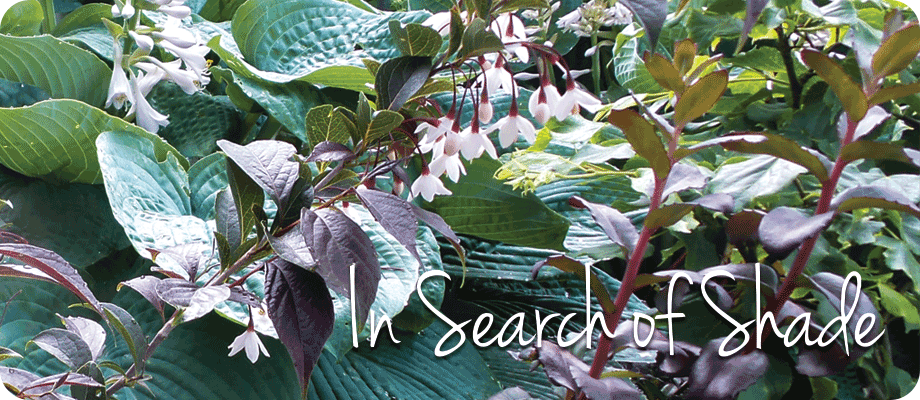
by Susan | Jun 12, 2015 | LB Tutorial: Design Challenge
Not surprising I suppose, most people in Washington State don’t have to worry about too much sun. Most lots are shady with many native trees which usually provides a place with enough shade to have a shade garden. As Robert Jones recently said ‘Shade plants are the more interesting plants’. I love shade plants but on my little piece of earth there is a lot of sun. Most of the property receives full sun all day except by the upper pond. That area receives the hot afternoon sun. Many good shade plants cannot take that type of exposure. The wonderful ariseamas, trilliums, hellebores, epimediums, paris, michela, camillia, solomans seal… You get what I mean, these cool shade plants will not be happy there.
The solution? Plant trees!
This means I actually get to plant some wonderful trees I’ve wanted to grow including some trees of my plant sale adventures like the Magnolia Wilsonii, Magnolia laevifolia, and Aesculus Hisp. ‘laciniata’. Of course there are some trees that have been removed from other gardens that were not good enough after delivery or just weirdly shaped that also get a place in my garden. There is a Japanese maple that was delivered from a grower that looked so bad I couldn’t put it in a client’s garden. I’ve had it for a while and it still doesn’t look good. In it went anyway. A black tulip magnolia with ½ a root ball, I’m not sure will make it. A dogwood that refused to bloom at a customer’s that I replaced with a more prolific bloomer. A red horse Chestnut that I purchased but never had a place for before, and a new cultivar of Cornus called ‘mandarin Jewel’ with orange fruit in the fall.
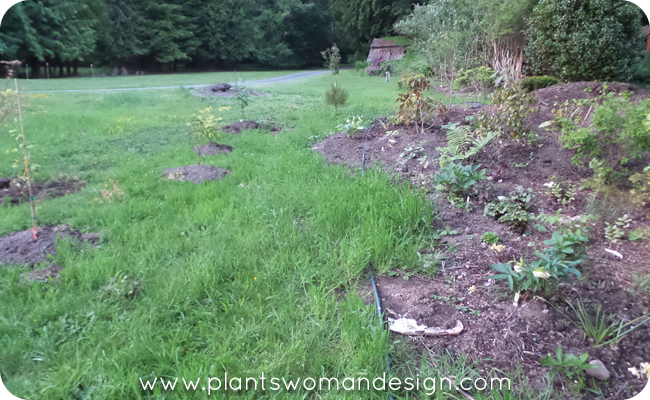
“before” – plant storage area
Now for the plan: I have been placing plants along the edge of the pond in partial shade since I moved in. Plants I saved from my old house and new things I’ve collected. The edge of the pond has gravel around it with lots of black plastic. To create the bed I removed the gravel and black plastic. Then, mixing new soil and compost together, I built up the bed and planted.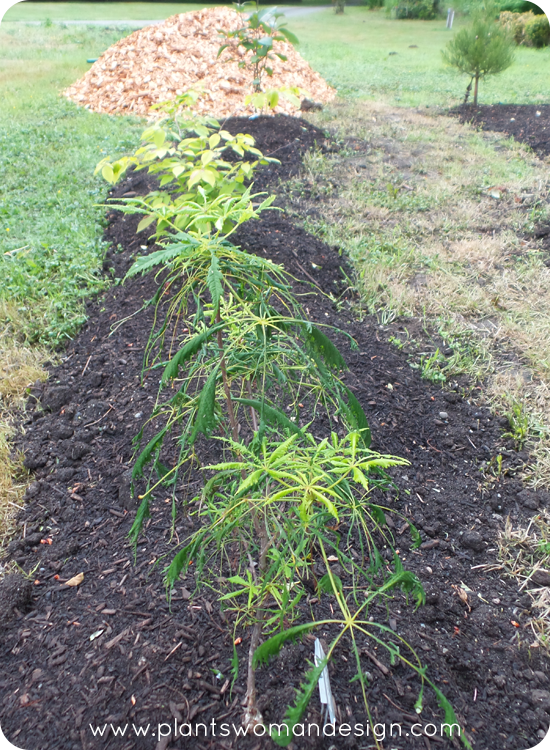 I want the trees to provide shade but I also needed to create a place to walk next to the shade plants. Placing the trees close together would obliterate the view of the plants so I placed them about 20 – 25 feet away from the shade plants. This will be a path after removing the grass there and putting down a good layer of wood chips. I hope to contact a wood-cutter to give me some of the chips left over from clean up.
I want the trees to provide shade but I also needed to create a place to walk next to the shade plants. Placing the trees close together would obliterate the view of the plants so I placed them about 20 – 25 feet away from the shade plants. This will be a path after removing the grass there and putting down a good layer of wood chips. I hope to contact a wood-cutter to give me some of the chips left over from clean up.
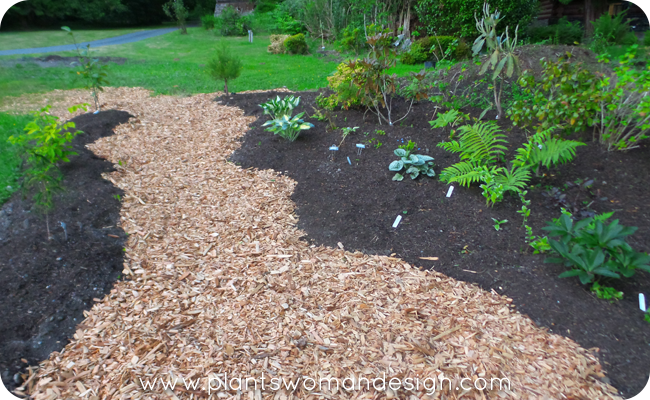
“after” – fully planted bed with walk
Cedar Play chips is the best material to use for the pathway. You can use other types of chips but the flat play chips make a good walking surface. The garden beds were weeded before the compost when down and the play chips in the center.
You can now see the pathway better and the indent of the beds. I’ll keep you posted as it grows in.
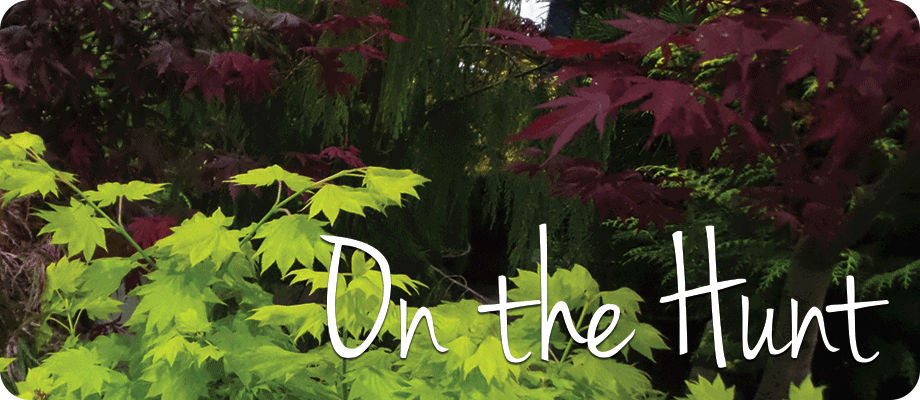
by Susan | Jun 5, 2015 | garden travel
Tis the season for hunting down your new favorite plants! I read a lot and communicate with people all over the world about plants and each year I usually find one I’ve been obsessed about finding. Many times they are plants I’ve killed and want to try again. Sometimes they are plants I see growing in someone else’s garden and wonder why I can’t have them in my garden too. Zone 8 plants are always iffy but I can’t resist trying them and talking about how to grow them with the grower.
The independent plant sellers have a way to help us plantaholics find our fix. They combine their efforts at regional plant shows and sales each year. Best thing ever!! This year my obsession was the Loquat Plant – Eriobotrya Japonica. This evergreen stunner is growing happily in Portland at the McMenamins Edgefield garden. It is lovely, tropical looking and luscious. I started doing research on where to find it. I found several places in Oregon but not mail order places. I couldn’t really justify a trip to Oregon for just one plant. But to visit a show, to see many, many different plants, to be excited about new plants I’ve not seen before… that I could do.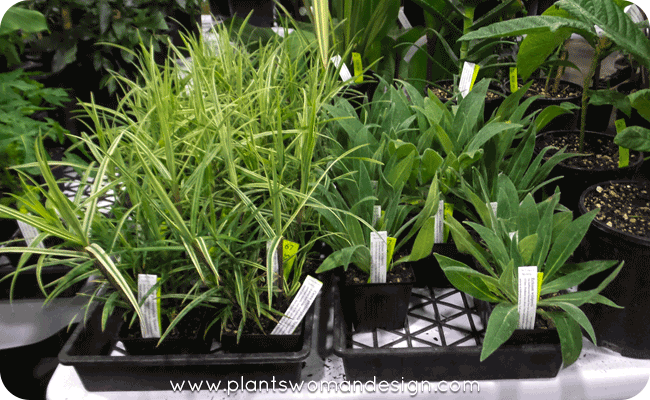
I contacted my friends at Cistus Nursery and they said they had a Loquat Plant I could grab while I was down there. So off I went to Hortlandia, a big horticultural show and sale in Portland. It was so amazing to see so many growers, so much plant material, so much knowledge and people so willing to share all in one place.
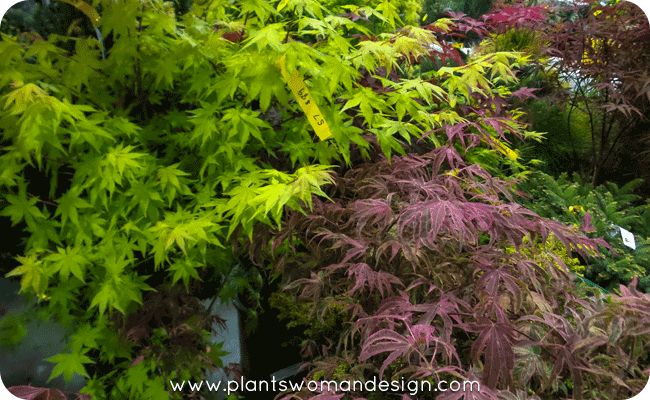
I was there just a few minutes and found the Eriobotrya Japonica. The grower was impressed that I knew what it was. But that is what an obsession is about… you know what you want, you see it in your dreams. I also got a fabulous hardy ginger, Hedychium greenii, Camassia leichtlinii ‘Sacajawea’ and several non hardy tropicals, including an aloe dorotheae, and alocasia ‘Regal Shield’.
My biggest problem always lies in how to get the bounty to my car after visiting all the fabulous growers. But the show makes it easy. You simply gather what you want, drop it off and they store it all until you were done shopping. After shopping you just take your little treasures to the check out tables where they ring up your order. After you finished there is a group of volunteer teens ready to move your take to an outside holding area while you get your car then help you load it! Amazing.
There are also several plant sales in my area to temp me. Heronswood had a sale in April and is open off and on through out the season. The Arboretum Foundation has FlorAbundance in April and FallAbundance in September. Independent nurseries bring their best plants to temp you. It is best to come early because the best things are gone fast! Here are a few things from my garden that I got last year.
Check out the plant sales in your area and keep purchasing from independent nurseries to keep the trade alive and new plants coming.
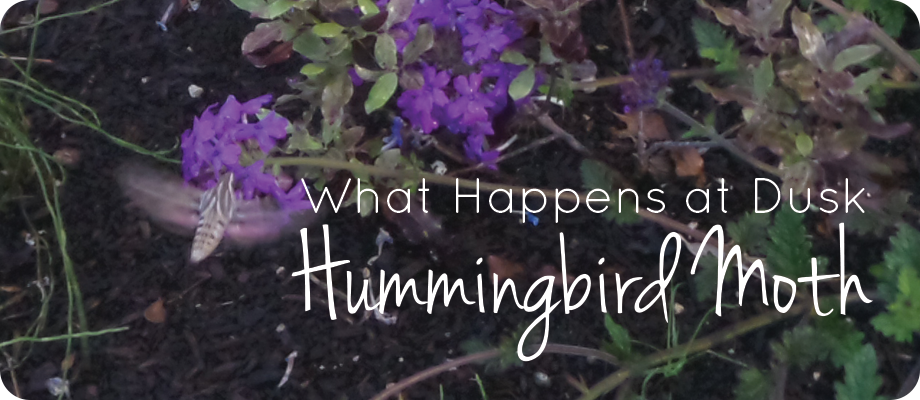
by Susan | Jun 2, 2015 | gardening
Sometimes it is hard to quit gardening. I putter, water, weed, deadhead, look, pick, and plant well into the evening hours. I guess it is an obsession (Duh right?). A warm Sunday evening found me putting away the remainder of my tools, wrapping up hoses, and cleaning up. While doing this I was buzzed by a large insect. Why would a humming bird be out this late? What else could it be? I stood still and waited for a return visit. Again a buzz, and flutter of wings past me, and again I thought humming bird. Soon another joined the first and then a third. Standing very still I started to observe what was going on. I ran in to get my camera and quietly came back. Unbelievable. A black and white insect with wings that beat so fast you could not see them. It has a long proboscis and was darting from flower to flower pollinating.
After the video session, where the star of the show continued to fly around, a visit to Google was in store. I looked up hummingbird and moth together. I found several types of Hummingbird Moths and identified mine. It is a Hyles Lineata or White Sphinx Moth. The common name comes from the way they fly, with wings moving in a blur, and hovering for nectar like a humming bird. This one was so cool. The zebra like striping and the red/pink wing edges were beautiful.
In all the years I have lived here and gardened I had never spotted one before. I don’t know if they are new to my area or because of the location of the property I’m the new one to the area.
Here are some more facts about these fascinating creatures…
- They are not considered a pest and usually inhabit desert areas, or warm areas. It was a warm night and when I looked for them on subsequent nights when it was cooler I didn’t see them. Some information suggests that when they colonize an area they will move further north to colonize another area. Possibly the explanation of why I’ve never seen them before.
- Adults fly at dusk, during the night and at dawn.
- Caterpillars pupate in shallow burrows in the ground. A
- dults eat nectar form columbines, larkspurs, petunia, honeysuckle, moonvine, bouncing bet, lilac, clovers, thistles, and Jimson Weed. Mine were on Verbena ‘Homestead Purple’. They like tubular flowers like the Hummingbird.
Enjoy this video and be on the lookout! You may have them in your garden too. Let me know if you see them.
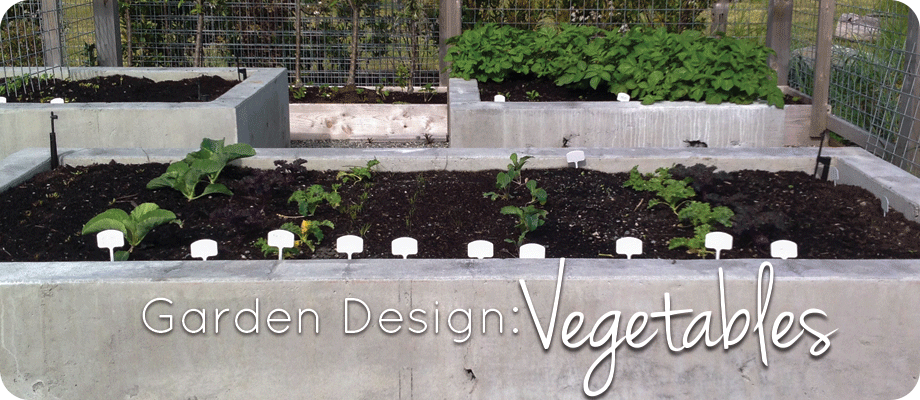
by Susan | May 22, 2015 | garden food, LB Tutorial: Design Challenge
There are times when I wonder if other designers get to design and plant vegetable gardens. I feel lucky that way! Recently I got to design and plant a veg garden for clients who only come in during the summer.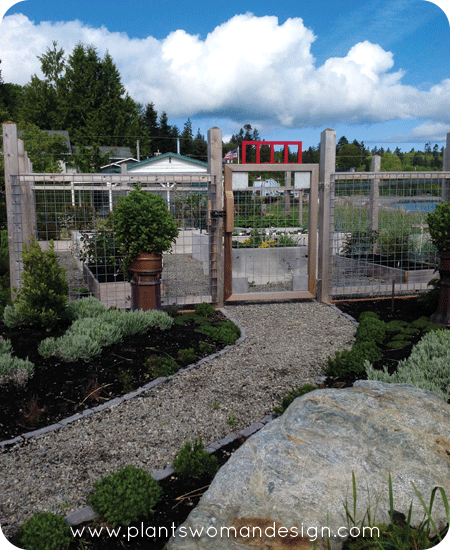 Obviously without year round residents a fence is needed. Because we aren’t sure how many deer are in the area the whole of the edibles and roses are protected. The fencing is galvanized wire and is connected to 8 x 8 cedar posts, the metal work on the gate was created by the owner. They put the fencing and gate together as a weekend DIY project.
Obviously without year round residents a fence is needed. Because we aren’t sure how many deer are in the area the whole of the edibles and roses are protected. The fencing is galvanized wire and is connected to 8 x 8 cedar posts, the metal work on the gate was created by the owner. They put the fencing and gate together as a weekend DIY project.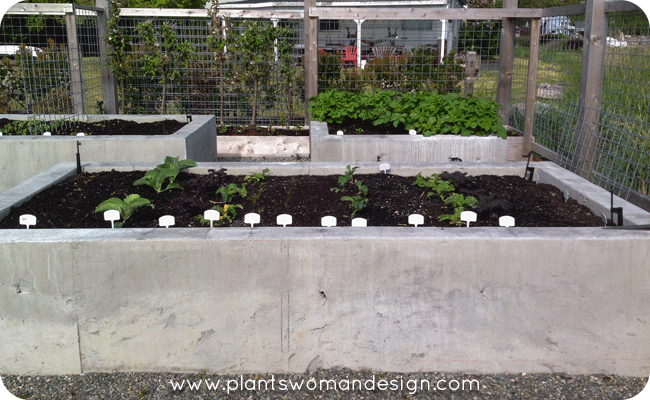 The raised beds are concrete poured into forms but not packed down to give it a rustic finish. We left the with bottom of the form open for good drainage and installed landscape fabric membrane over the native soil at the bottom of the beds to keep the beach grass out. Water is able to go through the soil and into the native soil beneath.
The raised beds are concrete poured into forms but not packed down to give it a rustic finish. We left the with bottom of the form open for good drainage and installed landscape fabric membrane over the native soil at the bottom of the beds to keep the beach grass out. Water is able to go through the soil and into the native soil beneath.
Drip irrigation was added with spray emitters at the corners and along the edge for good coverage. This system connected to the main irrigation system but is on a separate zone. We added a frost free hydrant for extra water when needed.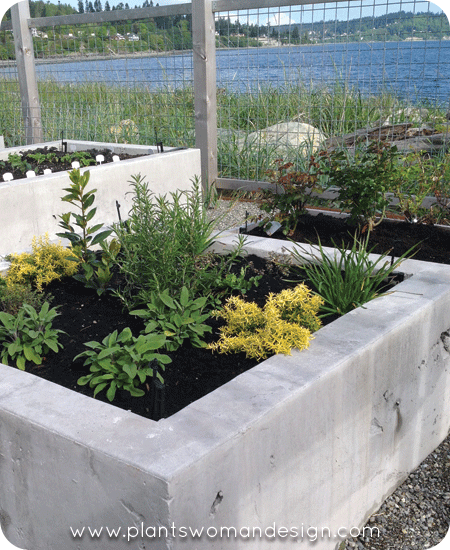 The first bed is the herb bed with a center cone of rosemary and a bay tree. Basil will be added later when it gets warmer.
The first bed is the herb bed with a center cone of rosemary and a bay tree. Basil will be added later when it gets warmer.
Early spring crops were put in first with some starts of kale and broccoli added along with the seeds of the same. I used different colors of kale and chard along with several colors of lettuce to make patterns in the planting. Red leafed lettuces, Radicchio, Romaine lettuce, spinach, and arugula are all planted in rows to make a pattern.
Fun purple beans, purple sprouting broccoli and watermelon radishes add some interest and more color. One bed is dedicated to exuberant potatoes both fingerling and yukon gold. Chard is tucked in there for fall color. We dig the potatoes out in the spring removing some. Here in the Pacific Northwest potaties continue to grow all year so will get too congested if left on their own.
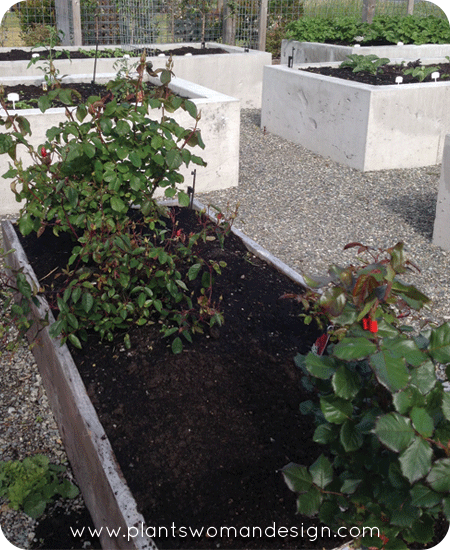 Two side beds hold a collection of roses for cutting. Two new ones we are trying this year are Chihuly and Anna’s Promise.
Two side beds hold a collection of roses for cutting. Two new ones we are trying this year are Chihuly and Anna’s Promise.
How many of you readers grow a vegetable garden along with the decorative ornamentals? Tell me what your favorite vegetables or herbs are!




